-
How to Save Money with a Clothesline
Years ago, using a clothesline, drying rack or even bushes to dry clothing was the only method available. Today we have become used to drying our clothes in dryers. It’s easy and convenient. But it also uses unnecessary energy and costs more than you may think. Using a dryer can cost you over a hundred dollars per year, depending on how much laundry you do. You can find out exactly how much it costs to run your electric dryer by multiplying your dryer’s wattage by the length of run time in hours and dividing by 1000. Multiply this number by your cost per kilowatt on your electric bill. Then multiply the number of monthly loads you do to determine your monthly cost for using your dryer. Gas dryers cost on average 11 cents per hour plus 12 cents per hour for electricity to power the drum. Here are some great options for skipping the dryer and saving money.

Source: Pinterest Old Fashioned Clothesline
I have been hanging clothes on the clothesline since my three boys were little shavers. Back then, we lived in an old Victorian home that had a huge clothesline I just loved. It was approximately twenty feet long with four lines which were always completely filled when I did laundry!

Available at amazon.com, this collapsible rack can also be used to dry herbs. Drying Racks
Even if you live in a tiny apartment, like I once did, you can use a drying rack like this one from Amazon. You can even use your shower curtain rod to hang clothes to dry!
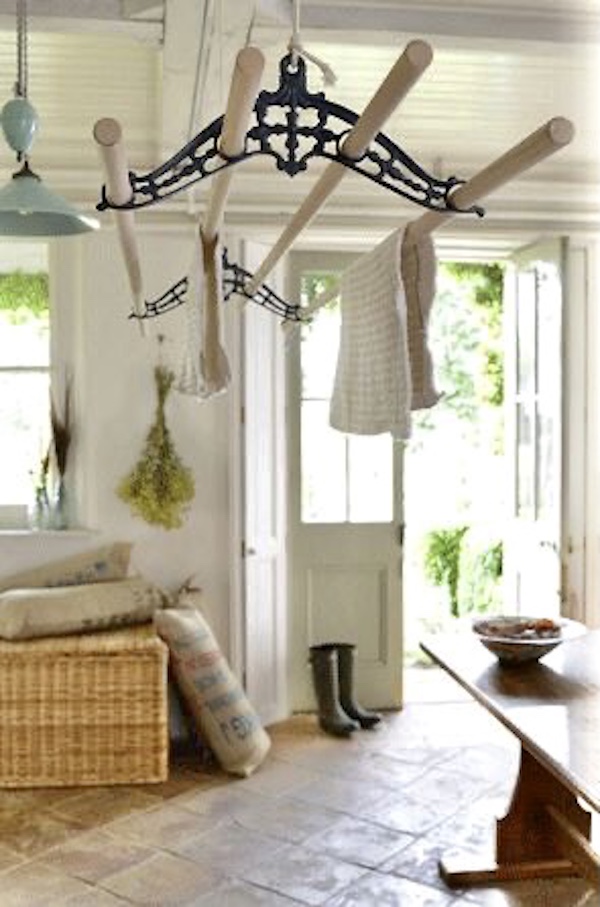
Elgan Clothes Airer available at pulleymaid.com. Overhead Clothing Airer
Another option for drying laundry naturally is the overhead clothing airer. These originated in Europe back in the 1700s. They were built using a pulley system that lowers for your laundry items, then raises back up towards the ceiling where the home’s warmest air helps the drying process. They have recently become quite popular again. For a tutorial on building your own, see the Grit and Polish.
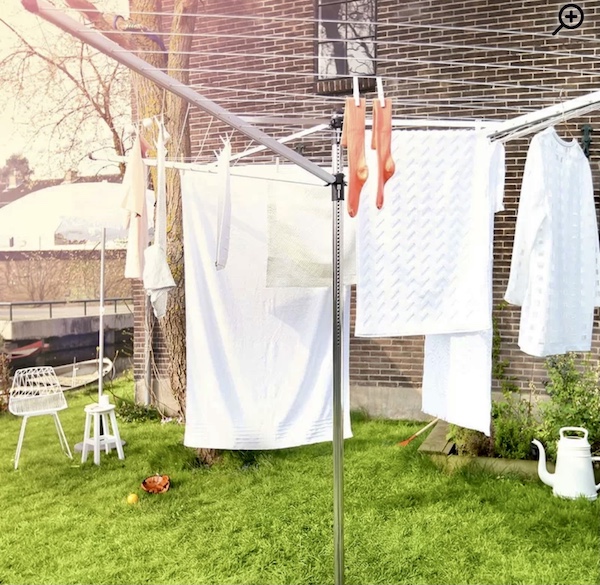
Rotary clothesline available at wayfair.com Clothesline Benefits
Benefits of hanging clothes vs. using a dryer are that they smell cleaner and fresher from being outdoors in the sunshine. You save on wear and tear from them being tumbled around and beat up in the dryer. You also avoid the “pilling” that occurs on items put in the dryer. Also, many clothing items such as blouses and sweaters are line dry only, and will inevitably shrink if you put them in the dryer. Reducing our drain on the planet’s energy is also beneficial. What I like most about hanging clothes on the clothesline is that it is relaxing. You have time to engage in a simple, repetitive activity that can actually be quite calming. I also like that you can sort the laundry as you hang it, pairing socks, etc. so there is no maddening struggle to match things up later. As an occupational therapist, I have used hanging laundry on a clothesline as a therapeutic activity in skilled nursing facilities. It is a great activity to work on fine and gross motor skills, eye hand coordination, and balance.
Helpful Tips
- To avoid wrinkles, always shake out wrinkle prone items a few times before hanging them on the clothesline. (Thanks to my Aunt Barb who taught me this many years ago!)
- When removing dry clothes from an outdoor clothesline, always give them a good shake before folding them. Years ago, I had folded a pair of my son’s jeans and was putting them in his drawer when I heard a buzzing sound. Lo and behold, I discovered a bumble bee inside his pants, which could have led to a most painful and unpleasant experience. Thankfully, this is a pretty uncommon occurrence, but one best to avoid.
- You don’t have to get fancy. You can purchase cheap, simple clotheslines at any hardware store. At my current home, the clothesline is strung between the posts on my back porch, and I have clothes drying racks as well.
Thank you for visiting my blog! You may also enjoy The Very Best Soothing Summer Herbal Teas and The Most Beautiful Instagrammable Spots in Monterey! Wishing you peace, love, happiness, and beautiful vistas.
-
The Very Best Soothing Summer Herbal Teas
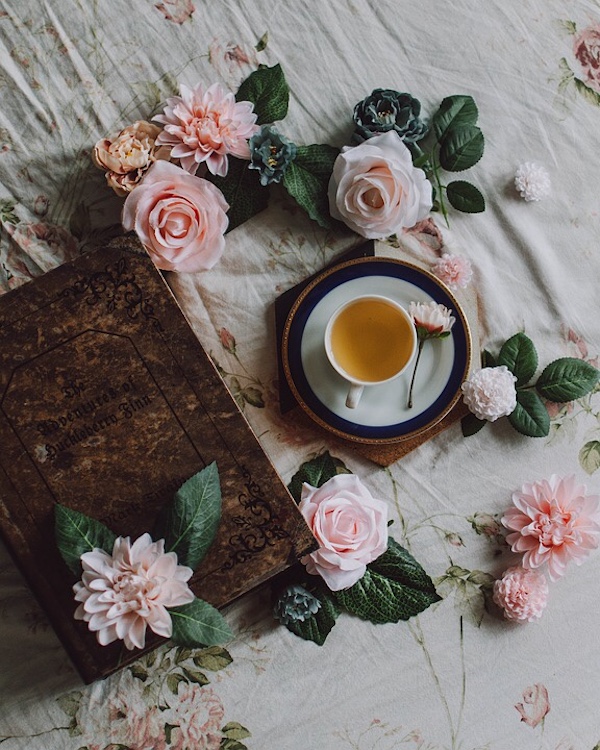
Have you planted herbs that are going growing like crazy now? Or maybe you picked up a bunch of herbs at the farmer’s market and are wondering what to do with them all? Herbal teas are a great way to use them. A cup of tea is one of life’s greatest comforts, and herbal tea can help you stay hydrated and healthy. Many herbs contain vitamins and antioxidants that help strengthen our immune systems and give us energy. They may also have essential oils, minerals and fiber that contribute to overall well-being. Here are some great ways to use those herbs to create homemade teas to help heal your mind and body. The best part is that unlike regular tea, there is NO caffeine. Each recipe is for one cup of herbal tea. For each recipe, pour boiling water over the herbs and steep for 8-10 minutes. The final step? Strain the herbs, and enjoy!
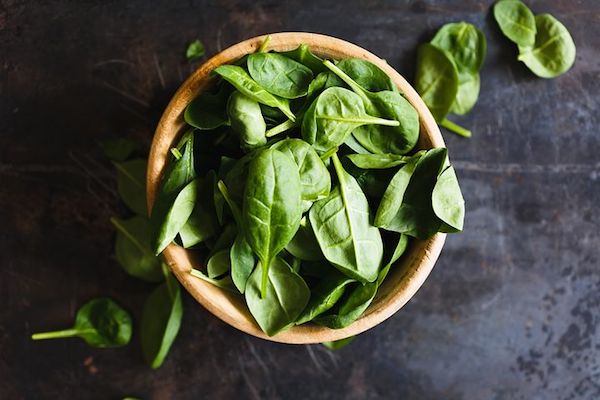
Peppermint Basil Potion
Peppermint tea is often used for soothing heartburn and tummy troubles. Basil is clean and refreshing. Use two teaspoons of chopped peppermint leaves and 4-5 basil leaves.

Ginger Hugs Tea
This tea is useful for stuffy colds and also brings energy and healing. Use a teaspoon of fresh ginger, a teaspoon of chopped mint, and a squeeze of lemon. You can add honey to sweeten it if desired.

Smarty Pants
Smarty pants tea may assist with sharpening memory and concentration. Use 1/2 teaspoon rosemary leaves and 2 teaspoons chopped spearmint.
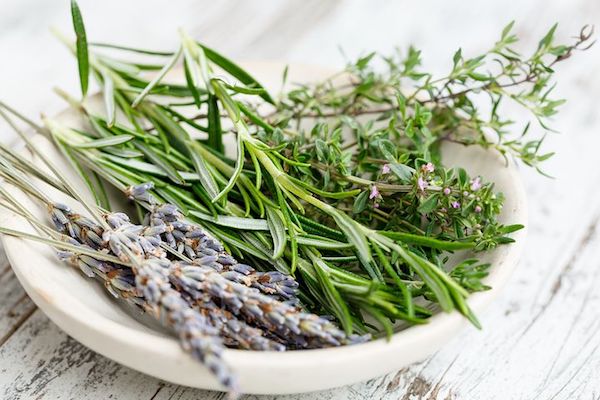
Love & Peace
This tea is great to drink when you are feeling bummed out or overwhelmed. Use a teaspoon of lavender, a teaspoon of jasmine flowers, and 1 cinnamon stick. Use only Jasminum species such as J. officinale, J. sambac, or J. polyanthum. Pick the flowers during the warmth of the day when the dew has dried, as buds or freshly opened flowers. Lavender relaxes the body and decreases anxiety. Jasmine has anti-inflammatory properties and reduces stress. Both scents are known to induce calm. Cinnamon is known to increase mental focus and help upset stomachs. The scent of this tea is heavenly.

Calming Chamomile
Another calming tea, chamomile is known to reduce stress and tension as well as fight bacteria. It can also improve digestion. It has a fruity, apple-like flavor. Use two teaspoons of chamomile flowers.

Delicious Dandelion
Dandelions are rich in vitamin K which helps prevent blood clots, and calcium which helps maintain bone health. It is also high in vitamin C and antioxidants, which help your body detoxify. Do not drink dandelion tea if you are allergic to ragweed and related plants as it may cause an adverse allergic reaction. It also interferes with the absorption of many common antibiotics. Do not drink dandelion tea if you are taking antibiotics. If you have discussed this with your physician and have been given approval as to its safety, use two to three teaspoons of dandelion flowers.
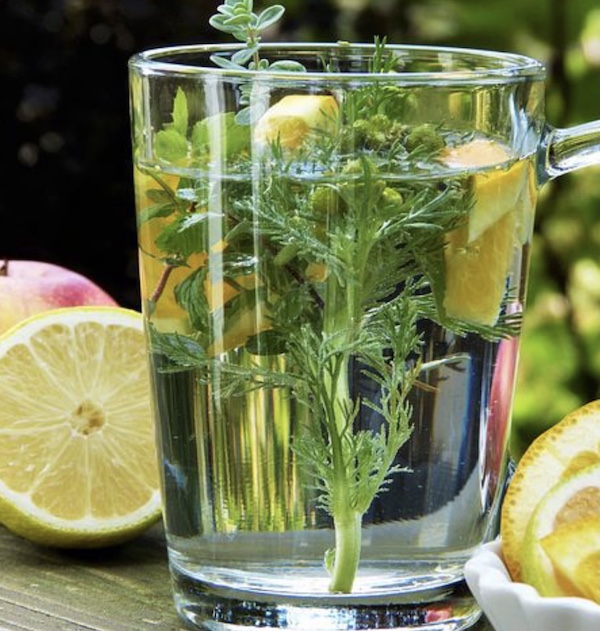
Fabulous Fennel Tea
The licorice flavor of fennel infuses this tea, and helps with digestion. Use a teaspoon of fennel seeds or several fennel leaves.

Luscious Lemon Verbena
Zesty and refreshing, this tea can also aid health including digestion and pain. Add one to two teaspoons of chopped or torn leaves to your cup.

Ravishing Rosemary Thyme
Bold and invigorating, this tea will give you a pop of invigoration. For one cup use one teaspoon rosemary leaves and two teaspoons lemon thyme leaves. You may add honey if it’s a little too strong.
Helpful Tips
- You can experiment with combining herbs you like to create your own unique concoction; just remember that the longer you steep your herbs, the stronger the flavor will be.
- When in doubt, don’t add too many herbs at the start. You can always add more, but you can’t add less!
- Use only organic, pesticide-free and chemical fertilizer-free herbs & flowers.
- You can substitute dried herbs for fresh, but the steep time will be shorter, usually only 3-4 minutes.
- Always talk to your physician and get approval before consuming any herbal tea to ensure your safety. Some herbs may interfere with medications you are taking, or may be dangerous due to possible health issues you may have.

Thank you for visiting my blog. You may also enjoy Nine Best Fresh Herbs To Use In Your Kitchen and 23 Yummiest Gluten Free Foods at Trader Joe’s. Wishing you peace, love, happiness, and beautiful vistas!
-
Amazing 4th of July Decor You’ll Love!

Banner available on Etsy at SunnyBanners. The 4th of July is rapidly approaching and I am busily digging out all my patriotic decor. Whether you like to just do a little something on the front porch or go all out, here are some amazing patriotic decor ideas I think you will love!
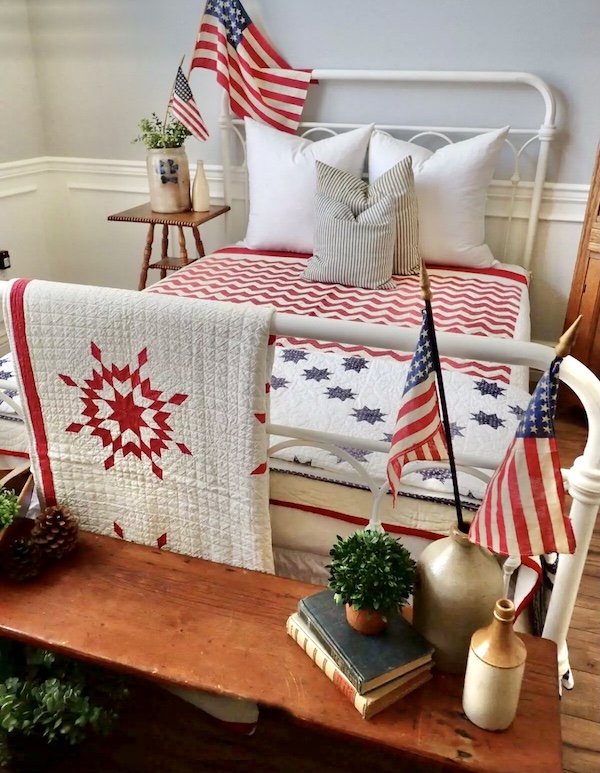
Using vintage quilts adds a cozy, comfy vibe that will make your 4th of July perfect.

Photo credit: Jamie Brown. Hand-made by Jamie Brown, this super cute “Old Glory” sign will help you celebrate Independence Day in style. Available at her Etsy shop, ToeFishArt, they are almost sold out!

Source: @myweatheredhome Get fab farmhouse vibes using vintage and rustic items.

Wreath available on Etsy, at The Door Charm. Using a patriotic wreath on a door or above the mantel adds the perfect patriotic touch. Check out Cari Anne’s beautiful creations on Etsy. I love the bows!

Source: @oops.i.dunn.it.again Stars and stripes make this dining room so 4th of July festive.

Source: Pottery Barn These Americana cotton/linen napkins will add 4th of July flair.

Chair Back Covers available on Etsy at SeasonalHeirlooms. Sometimes, just switching up something you already have will do the trick. How about these patriotic chair back covers! Isn’t this just the cutest?

Wow! Just can’t stop admiring this beautiful porch by Bonnie Ainsley Hunt @simple_and_lovely and owner of Simple and Lovely Art on Etsy.

Source: @rusticlivinglife Another beautiful 4th of July porch. Drooling!

Source: @houseonlouisemeadow The perfect patriotic place settings to make your celebration complete.

Source: @havenberryvintage Using vintage items to decorate for the 4th of July provides a unique glimpse of the past.

Curtains available at Bed Bath & Beyond. Show your true red, white & blue love with these flag curtains.

Source: Oriental Trading These simple burlap hanging fans create festive wall decor.
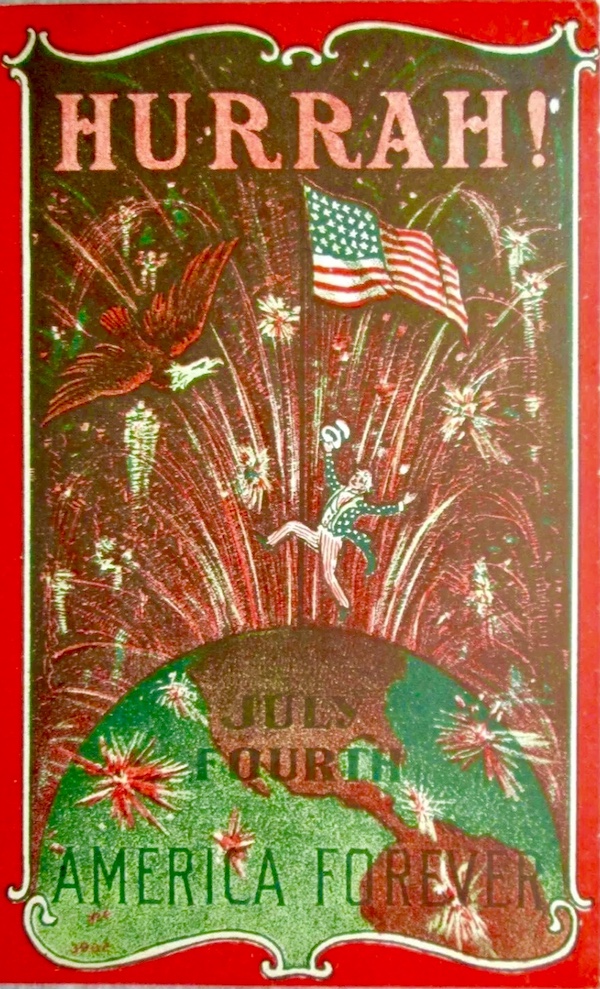
Thank you for visiting my blog! I hope you found some patriotic decor inspiration. You may also like The 5 Reasons You Will Love These Summer Finds!, What the Color of Your Flowers Says About You, and Garden Gates of Carmel. Wishing you peace, love, happiness, and beautiful vistas.
-
Cottage Love in Carmel-by-the-Sea
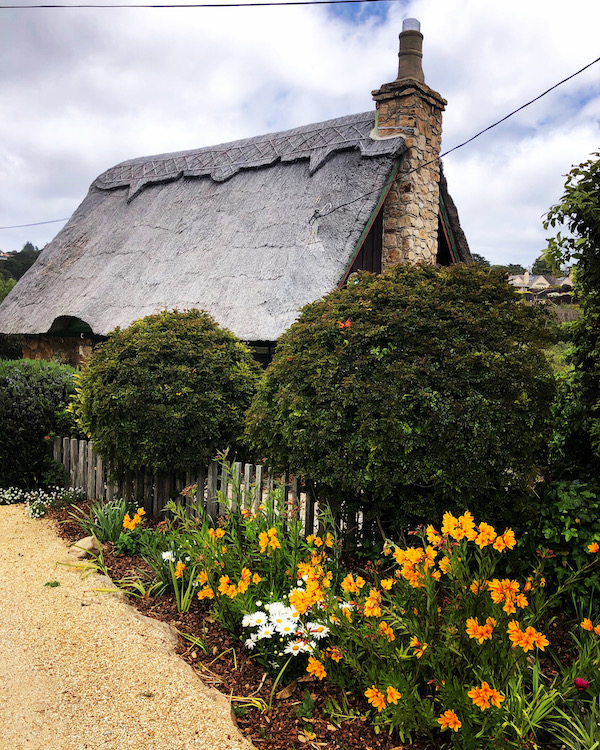
Originally settled by a band of bohemian artists and writers, Carmel-by-the-Sea is one of the prettiest cities you will ever see. Visitors feel as though they have stepped into something from Grimm’s Fairytales, and perhaps they have. Part of the allure of this seaside town arises from the storybook homes populating it. Romantic cottages are waiting to be discovered around every corner. There’s just something about these cozy abodes that tugs at your heartstrings and makes you fall in love with them. Here are some sappy but sweet cottage quotes about these lovelies. Enjoy!
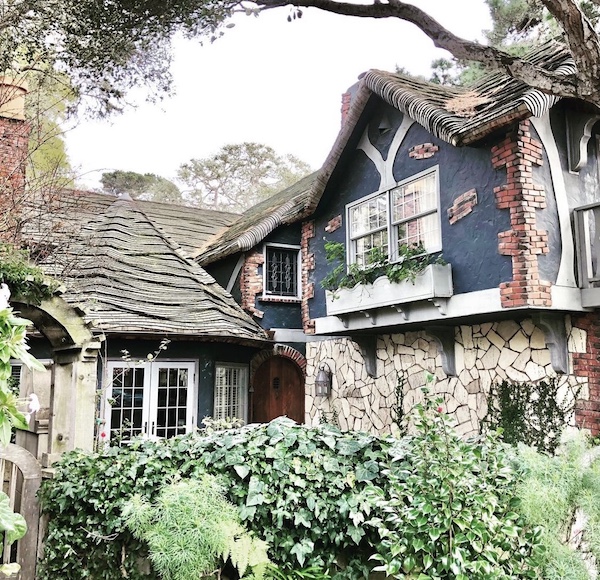
I am excessively fond of a cottage; there is always so much comfort, so much elegance about them. I advise everybody who is going to build, to build a cottage. ~ Jane Austen. Anything ever written by Jane Austen is solid advice, in my humble opinion.

Every antique farm-house and moss-grown cottage is a picture. ~ Washington Irving. This is true, hence my obsession for photographing them excessively.
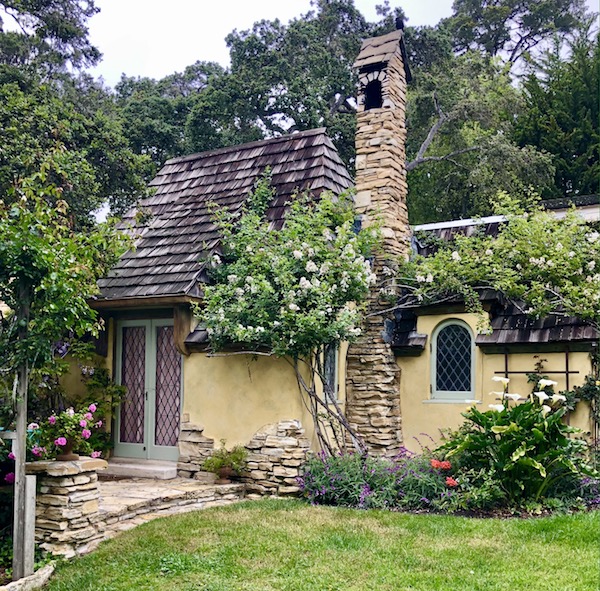
A cottage will hold as much happiness as would stock a palace. ~ Hamilton Wright Mabie. I have never lived in a palace, so cannot draw such a comparison. And even though I believe happiness comes from within, living in a Hugh Comstock dwelling like this would certainly amp up the happiness factor.

Everyone can identify with a fragrant garden, with beauty of sunset, with the quiet of nature, with a warm and cozy cottage. ~ Thomas Kinkade. Mr. Kinkade, of all people, understands the veracity of this statement.

Her modest looks the cottage might adorn, sweet as the primrose peeps beneath the thorn. ~ Oliver Goldsmith. These are actually clematis flowers and they do appear to be peeping over the gate. Petal peepers!
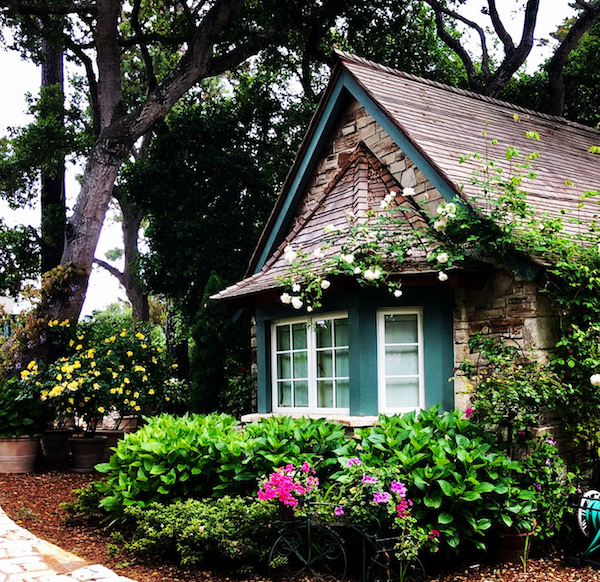
I knew by the smoke that so gracefully curl’d above the green elms, that a cottage was near. I said, “If there’s peace to be found in the world, a heart that was humble might hope for it here”. ~Thomas Moore. Agreed, I would love to find peace in this cottage!
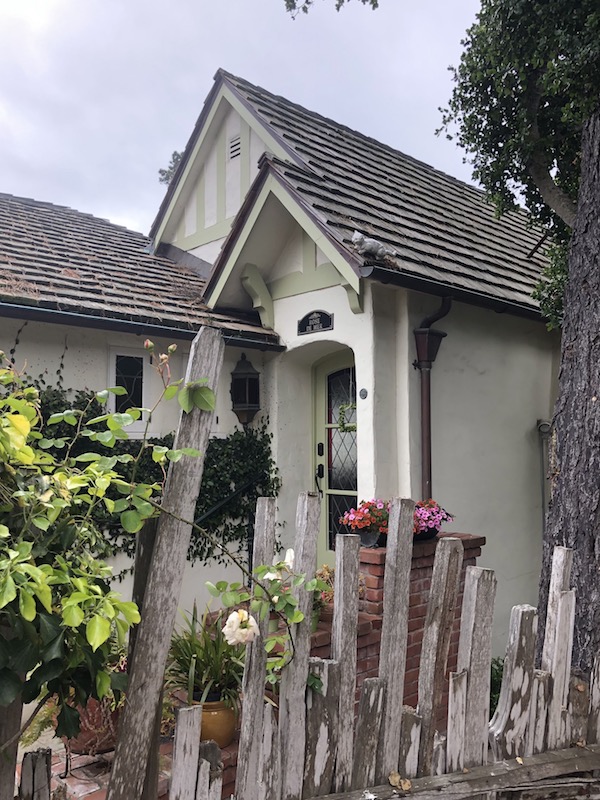
Give me the sea and a little cottage just to be. ~unknown. Definitely!
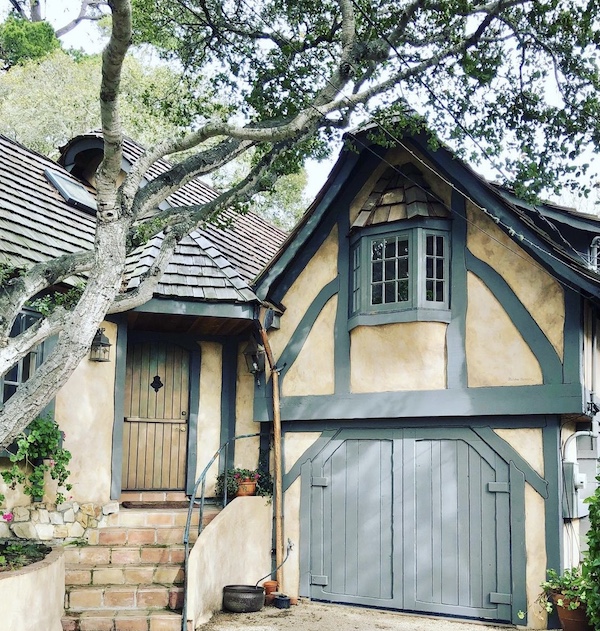
Thank you for visiting my blog. You may also enjoy The Garden Gate Story: Inspiration from Carmel-by-the-Sea, and Magical and Enchanting Gardens of Carmel-by-the-Sea. Wishing you peace, love, happiness, and beautiful vistas.

If only this were true! Source: Pinterest. ,
-
Flowers & Other Stories: Spring Gardens I Love
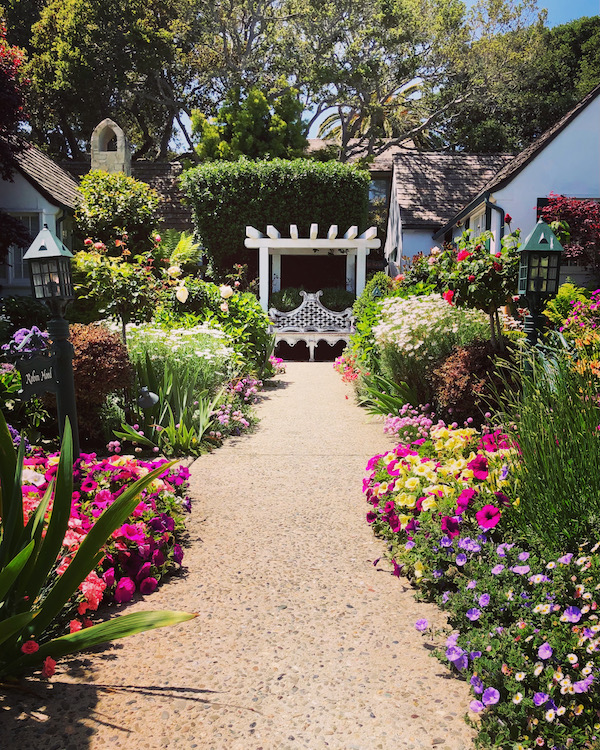
The garden at the Lincoln Green Inn in Carmel-by-the-Sea is an all-time favorite! Flowers make me happy, how about you? In the spring, Monterey County bedazzles with a bevy of blossoms. Gardens here become a riot of color and texture, as flowers tell their stories. I love seeing the blossoms magically appear, and like turning the pages in a book, discovering all the colors and textures as each garden comes alive. Here are some of my favorite local gardens in the spring.
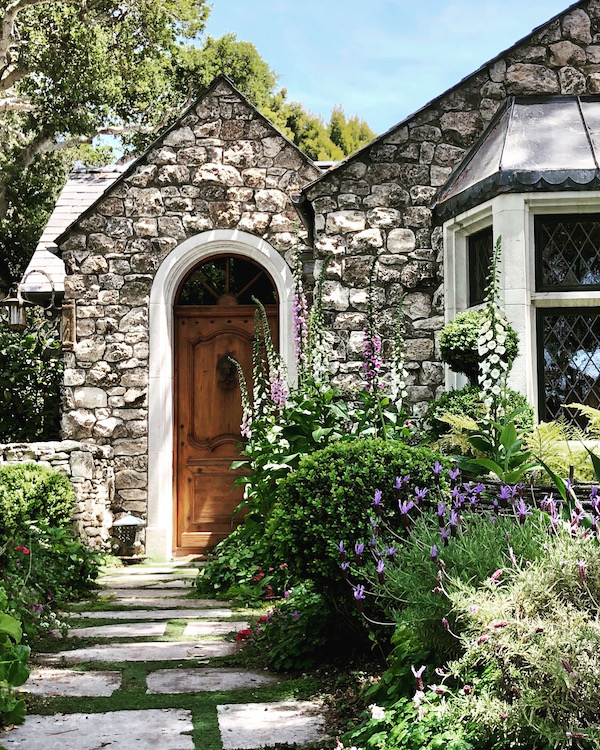
I love the foxgloves growing outside this stone cottage in Carmel in the spring. Cottage gardens have always pulled at my heartstrings, how about you?
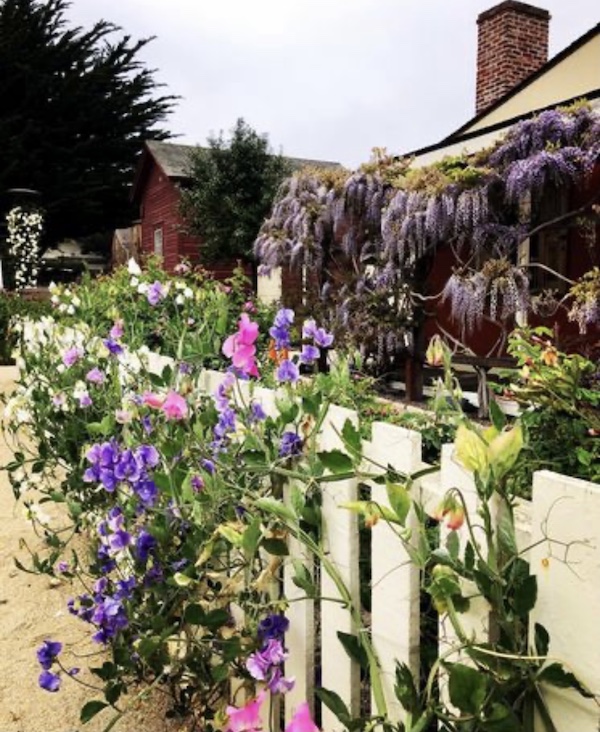
The spring flowers in the gardens at the Cooper Molera Adobe in Old Monterey are breathtaking. Sweet peas make me swoon; their scent is amazing!
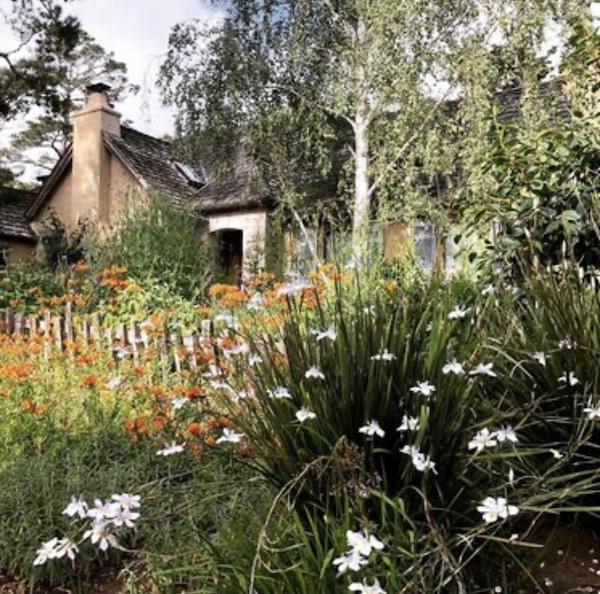
Fairytale gardens are like stories I want to read again and again. These flowers in Carmel-by-the-Sea are simply magical.
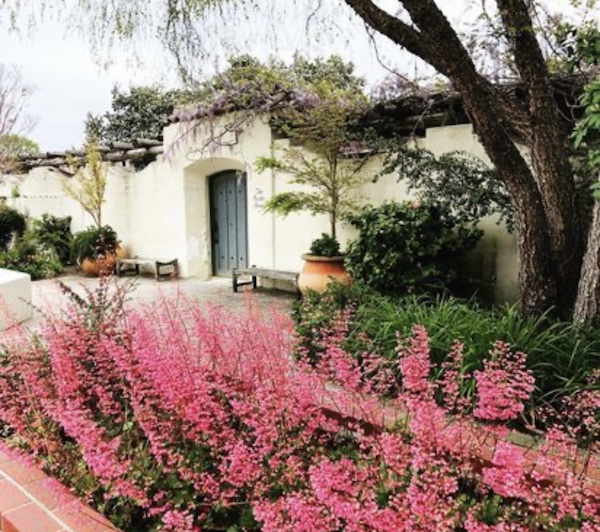
In the spring, the gardens at Casa del Oro and the Pacific House in Monterey are enchanting.
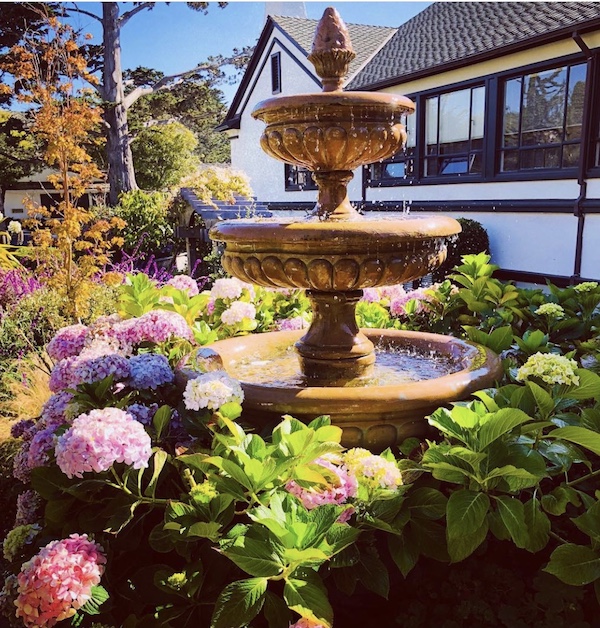
The Church of the Wayfarer in Carmel-by-the-Sea has a lovely flowers year round, but in the spring it simply sparkles.
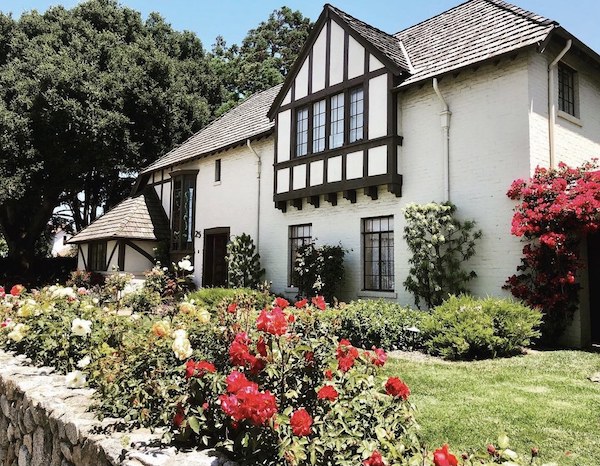
The Maple Park area in Salinas has many quaint vintage homes with magnificent gardens. I love the roses lining the old stone wall at this one.

Even the smallest homes with the tiniest yards can have the loveliest gardens. This one is located in Pacific Grove.

Larkin House in Monterey has a beautiful secret garden that just exudes peacefulness. There are benches everywhere to sit and relax. I love the rose covered pergola. There is even a very old stone well in the garden!
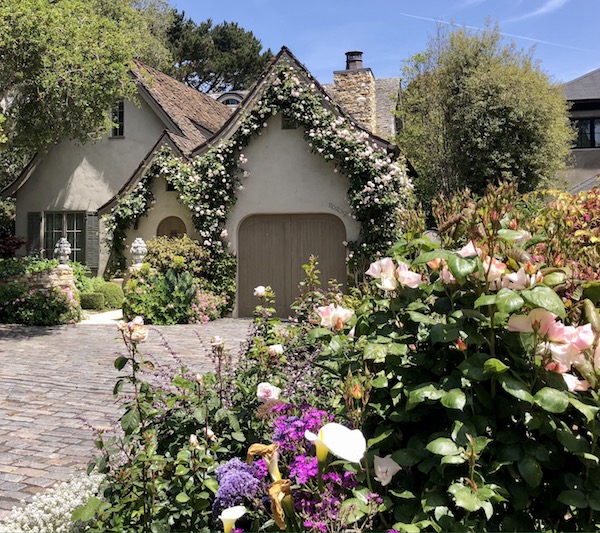
Another beauty from Carmel-by-the-Sea. Do you love the house or the flowers more?
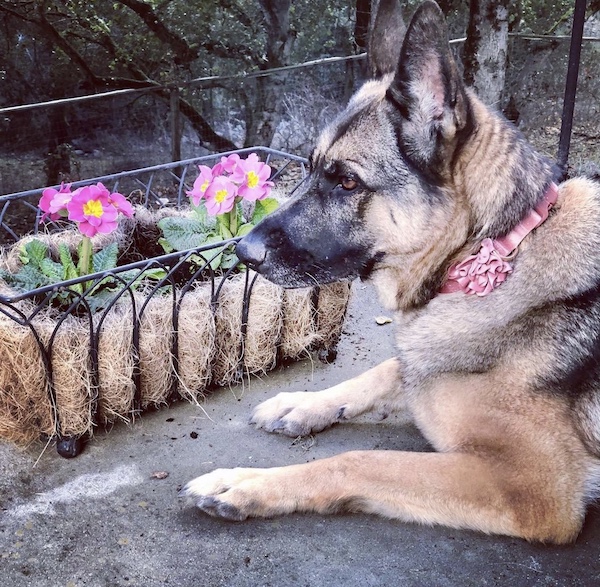
My dog Sasha with some of my favorite spring flowers–primroses! I hope you enjoyed flowers and other stories. You may also like What the Color of Your Flowers Says About You and Enchanting Gardens of Carmel-by-the-Sea. Wishing you peace, love, happiness & beautiful vistas!
-
Cottagecore 101: An Introduction for Monterey Farmgirl
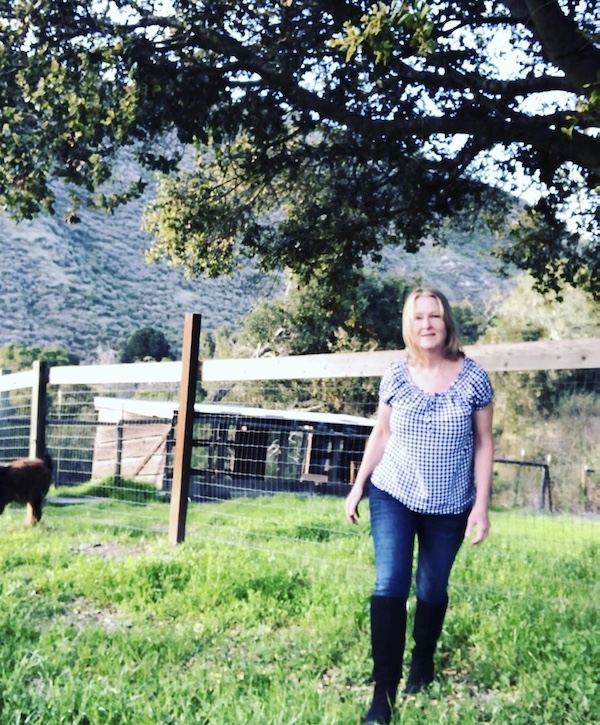
Recently, a friend of mine asked if she and her photographer could scope out my farm for a photo shoot for her business based in Carmel-by-the-Sea. “Sure thing!” I replied, although adding that the wildflowers here are a bit deflated this year due to lack of rain. “It’s going to be a cottagecore theme!” she said. At this point I admit I was a bit befuddled. What the heck is cottagecore?, I thought. I completely forgot about this word until she and the photographer arrived at my farm. The photographer and my friend starting discussing that word again–cottagecore. It still sounded very ambiguous to me. I went online to see if any of the local libraries carried books on cottagecore. Nope. It was time to get down to business. I had to know.
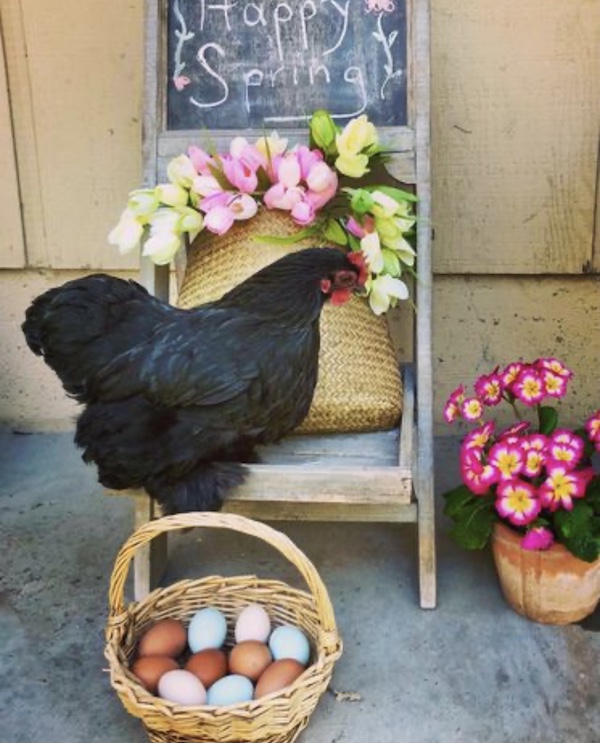
Mrs. Frizzle and our colorful eggs on the farm. According to Good Housekeeping, it is a “dreamy aesthetic taking over the internet”. Okay, still ambiguous. The article goes on to say that cottagecore “embraces the charm of the English countryside, creating an idealized representation of farm life – no matter where in the world you may live.” Hmmmm. Examples of this include tending a garden, sipping tea, and foraging for mushrooms to recreate a “pastoral fantasy”. At this point, I am thinking, “My God, I am cottagecore!” But am I? Am I unwittingly part of a trend? The answer is no. I am just living my own ding dang life with my animals on the farm, I love nature, and that is authentically who I am. No trendy Wendy here.

The Mushroom Forager’s Festival I attended in Big Sur. Blogger Sara McDaniel calls cottagecore “Narnia combined with Little House on the Prairie…a charmed, fantastical, dreamy way of life absent of modern stresses and combined with sustainable living”.
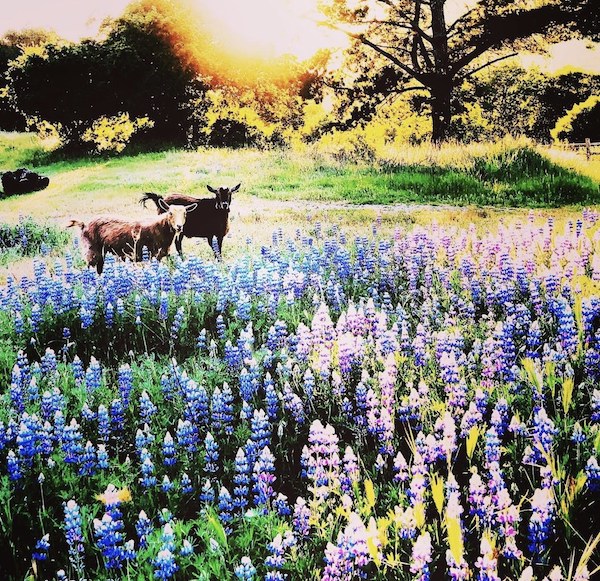
Wild lupines growing on my farm in 2020. Cottagecore is also referred to as farmcore and countrycore. Huffington Post states that it is returning to “our roots”, which they define as staying home, going green, wearing flowery dresses, writing letters, baking bread, embroidering, and everything DIY. It also stipulates that to be cottagecore, you should look and live “like you’re in some sort of pastoral painting”. But I do! I do!

My dancing goat, Yoda. I discovered that someone has indeed written a book on this topic. The Little Book of Cottagecore, by Emily Kent, has yet to be found anywhere locally. I am certain that since it is an internet sensation it is readily available online, should someone want to delve further into this. And it’s not just any old book, but a little book which sounds much cozier, does it not?
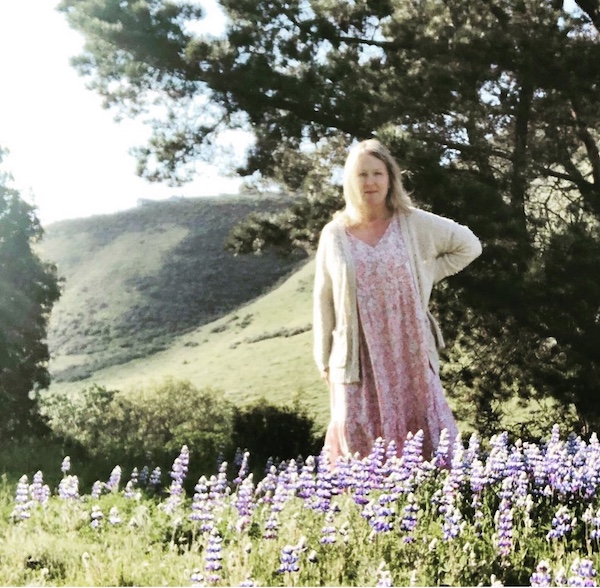
Monterey Farmgirl wearing a flowery dress in a pastoral setting on her farm in 2020. In the meantime, I am going to return to my granny square crocheting and think about making hand-dipped soy candles while the aroma of homemade banana bread wafts from my oven. Damn it, I am cottagecore.
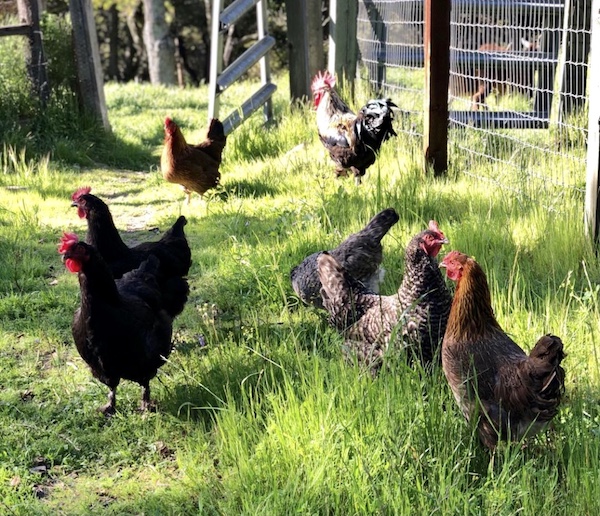
Thank you for visiting my blog. You may also enjoy reading Prettiest Wildflowers in Monterey County, From A-Z and Greatest Inspirational Goat Quotes Ever! Wishing you peace, love, happiness, and beautiful vistas!
-
The Amazing Art of the Topiary
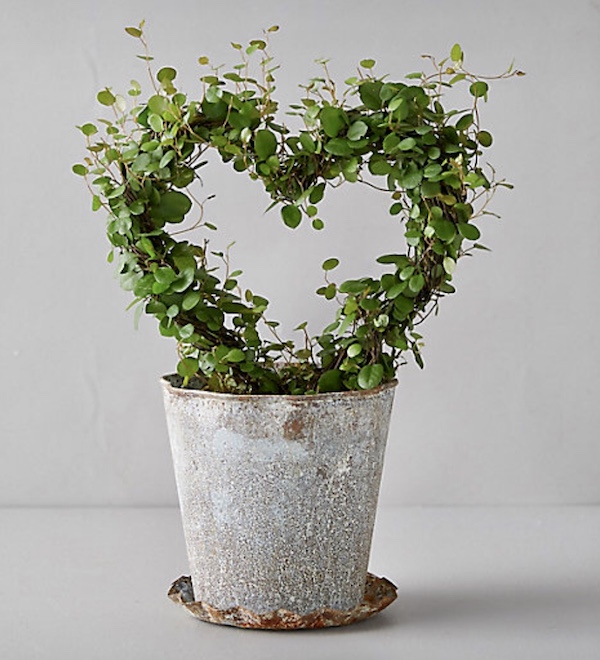
Topiary is the art of clipping shrubs, trees, and vines into shapes. Topiaries have been around since Roman times, when they became popular during the reign of Julius Caesar. These living sculptures took the shape of animals, obelisks, hedges and more. It wasn’t until the 1600s that topiaries became popular once again. Formal gardens with shrubs clipped in geometric formations and mazes were fashionable. While interest in topiaries ebbed and waned over the years, they became popular again during the Victorian era, when the rage for formal gardens returned. Today, topiaries can add curb appeal to your home, and provide an artistic accent to your home and garden.
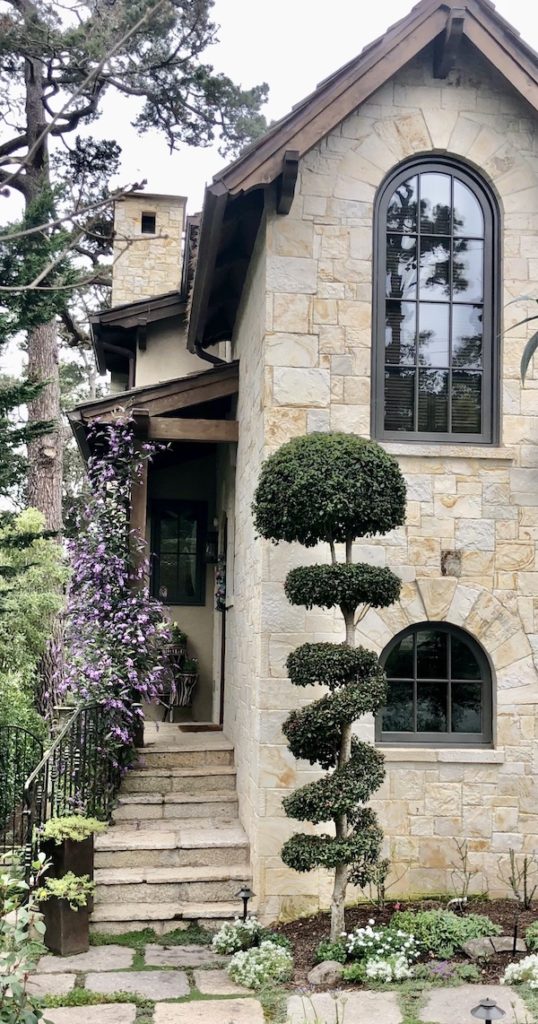
A topiary accentuates the front entry of a home in Carmel-by-the-Sea, California. It’s easy to create a topiary. The first thing you need to do is decide what shape you would like. Typical shapes are a cone, spiral, single, double, or triple ball, and animal shapes. It’s best to start with a simple shape if you are new to topiary design.
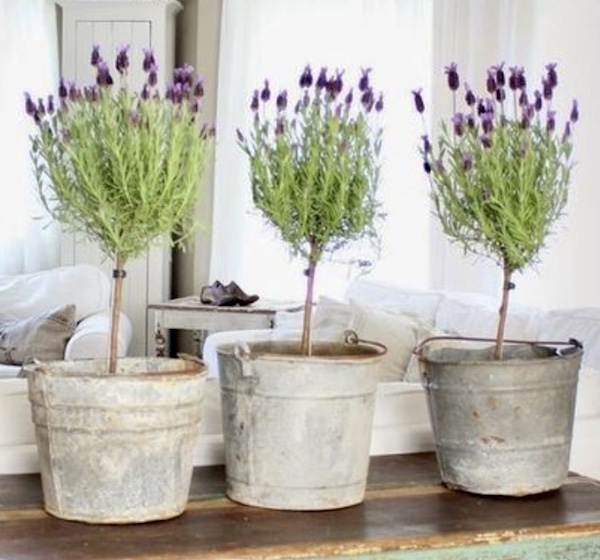
Spanish lavender topiaries add a casual vibe and smell wonderful! There are many plants that work great for topiaries. The best have small leaves, grow quickly, have dense foliage, and are easy to prune. Large topiary plants include yew, boxwood, holly, laurel, and privet. Small topiary plants include lavender, germander, rosemary, thyme, creeping fig, angel vine, and English ivy.
To grow vines such as ivy, angel vine, or creeping fig, it is best to have a form that it can pinned or wired to. It’s easy to create simple wire forms using single light gauge wire or even chicken wire. Simply cut the and bend the wire into the shape you want, then place into a container. You can also purchase pre-made topiary forms online. Wind the stems of the plant around the forms or attach them with pieces of florist’s wire.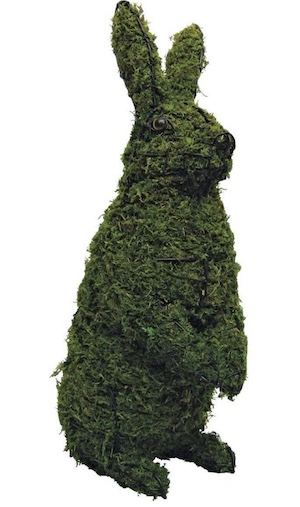
You can also use foam, garden sculptures, and even stuffed animals! Cut enough chicken wire to fit over the object. Use florist’s wire to finish off the seams, but leave a hole so you can remove the object. Leave the bottom open, then place over the plant you have chosen. You can also fill the form with sphagnum moss to give your topiary a bit of shape while your plant grows and fills in the gaps.
My ivy kitty topiary needs a trim! 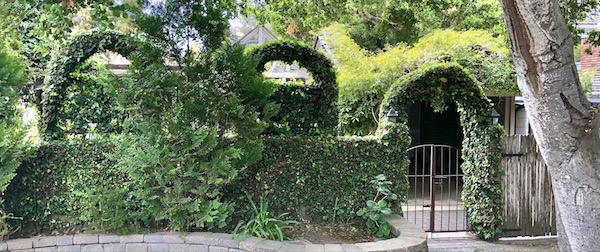
After you create your topiary, you will need to clip it regularly to keep it in shape. The more complex the design, the more frequently you will need to trim it. It is good to have a pair of topiary shears for optimal shaping work on smaller or more complex topiaries.

Thank you for visiting my blog! Topiaries are so much fun! I smile every time I see my cat topiary. And that’s what topiaries should be all about. You may also enjoy Flowers & Other Stories: Spring Gardens I Love and Have a Seat: Garden Bench Inspiration. Wishing you peace, love, happiness, & beautiful vistas!
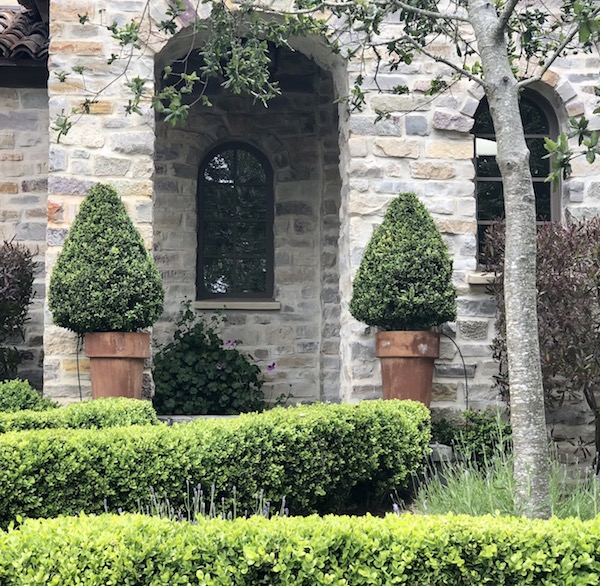
-
Happiness Found: San Jose’s Storybook Homes

According to WalletHub, San Jose is among the top ten happiest cities in the United States in 2021. While they did a study and have data to support this, I can tell you my own reasoning why it should make the list. Everything seems somehow brighter and more vibrant here. The sky is a little bluer, the trees a little greener, and the air a little sweeter. Even though it is a huge city, there is also a peaceful sense of community and small town friendliness. It just exudes some kind of invisible harmonious energy. While visiting the Municipal Rose Garden this past week, I stumbled upon another reason San Jose qualifies for this list. San Jose’s stunning variety of storybook homes! It was a beautiful bit of serendipity, and indeed I felt truly, deeply happy.
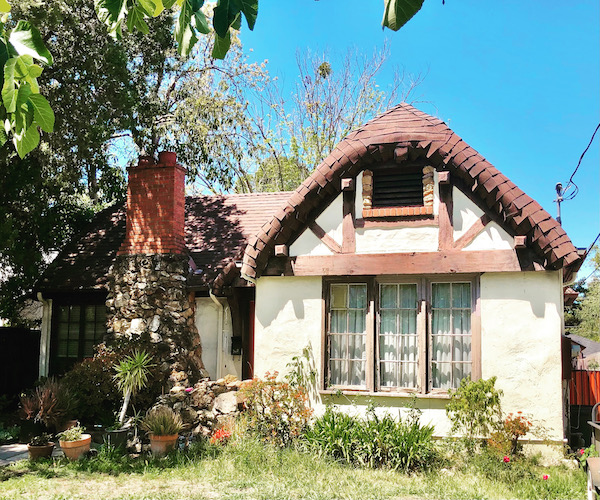
I have become a hopeless addict of these magical cottages, ever since I moved to the Monterey Bay area and discovered the Fairy Tale Cottages in Carmel-by-the-Sea. Storybook homes became very popular during the 1920s, especially here in California. Those steeply pitched gables, oddly shaped windows and doors, and crooked little stone chimneys just speak to me. Imagine my delight when I turned on a side street near the rose garden and unexpectedly hit the bonanza!

The majority were on McDaniel and Emery, near the rose garden. I also discovered more of these captivating cottages on Calaveras and Shasta. I was in storybook heaven! It was like stepping into a fairy tale.

I love the quirky tower and the texture of the stones framing the door. The little fence carries over the natural stone theme.
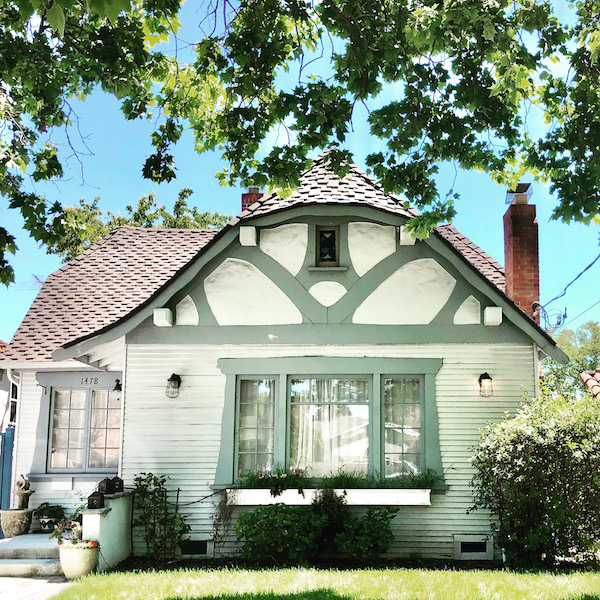
This looks like it is straight out of Goldilocks and the Three Bears.

The storybook homes here just feel so cozy.

A rose canopy on the front window of this house is simply enchanting.
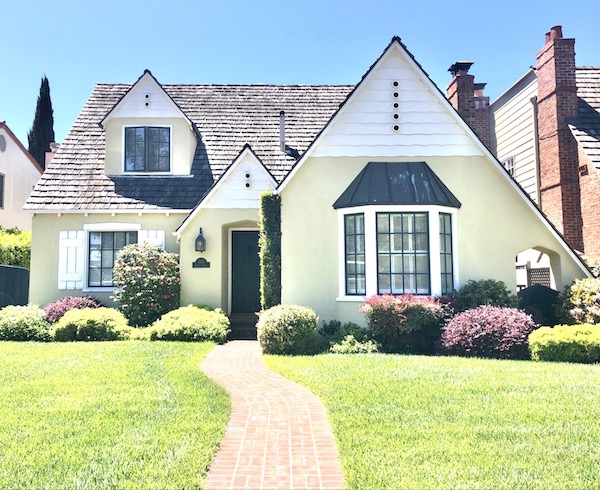
This house directly faces the Municipal Rose Garden.
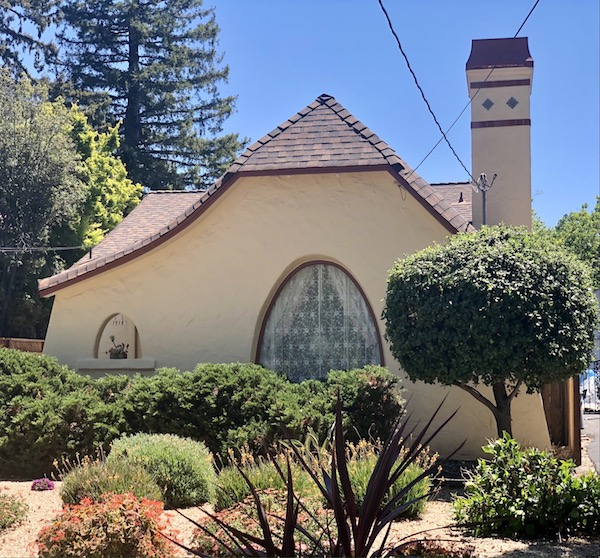
I love how the little cut out window on the left mirrors the big picture window.
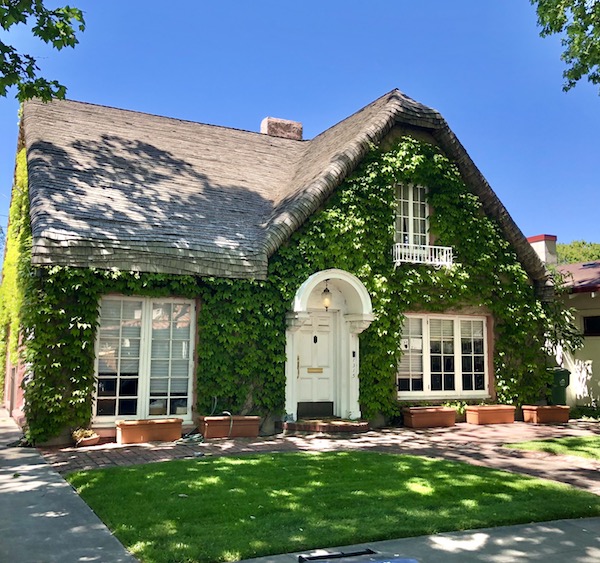
This should definitely be called Ivy Cottage. 
Surrounded by bird of paradise flowers, this home features whimsical windows and randomly placed bricks near the entryway.
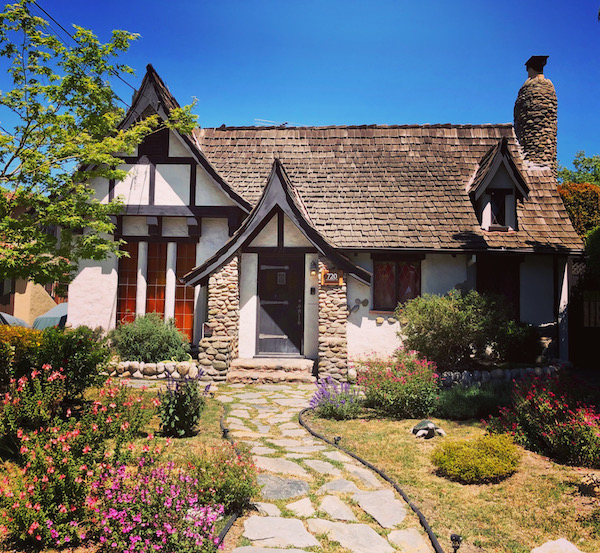
I saved the best for last! I love the quaint stone chimney, little dormer window, and curving pathway of this charming cottage. Thank you for visiting my blog. I hope you enjoyed the magical storybook homes of San Jose. They help us believe in a world where fairy tales still exist. And a place where everyone lives happily ever after. And finding happiness in all the little things is what life is all about. You may also enjoy 12 Storybook Cottages to Enchant You! Wishing you peace, love, happiness, and beautiful vistas!
-
What the Color of Your Flowers Says About You
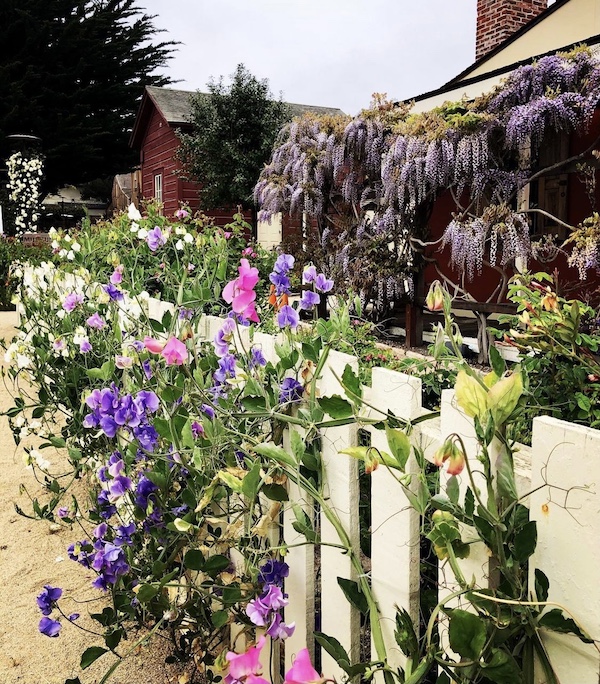
What is the first thing you notice about a flower? For most people, it is the color. Many people are unaware of the impact colors have on our thoughts, emotions, and behaviors in everyday life. When planting a garden, many people choose flowers instinctively, drawn to shades that subconsciously may be revealing their true personalities. Here is what the color of flowers you choose says about you!


Red. Red geraniums, dahlias, roses, tulips and more are some plants red loving gardeners may choose. Chances are, if you love the color red, you are an extrovert. Other traits you may possess include enthusiasm, passion, and adventure seeking. Red lovers may also be bold, impulsive, and sometimes intimidating!

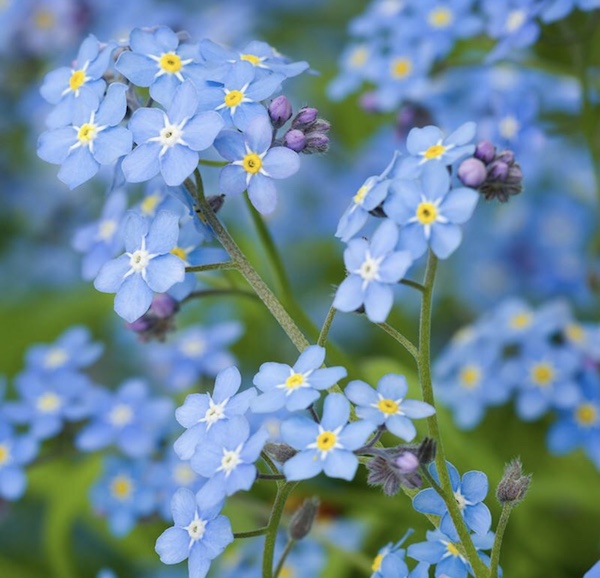
Blue. Delphiniums, irises, forget-me-nots, agapanthus, and phlox are flowers blue loving gardeners may select. Blue lovers are generally strong, conservative, peaceful, and trustworthy. People may look up to you due to your sensitivity, gentleness, stability, compassion. and loyalty.
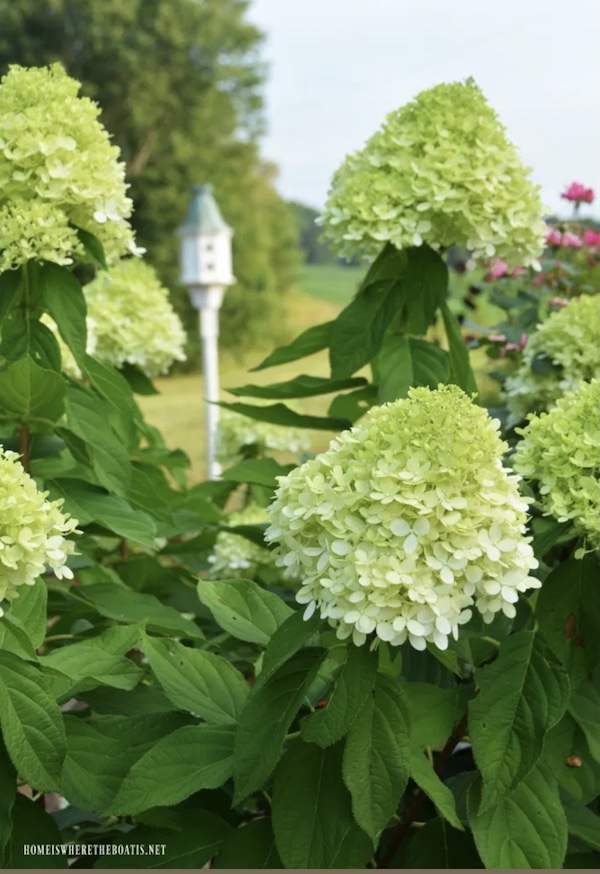
Photo courtesy of homeiswheretheboatis.net 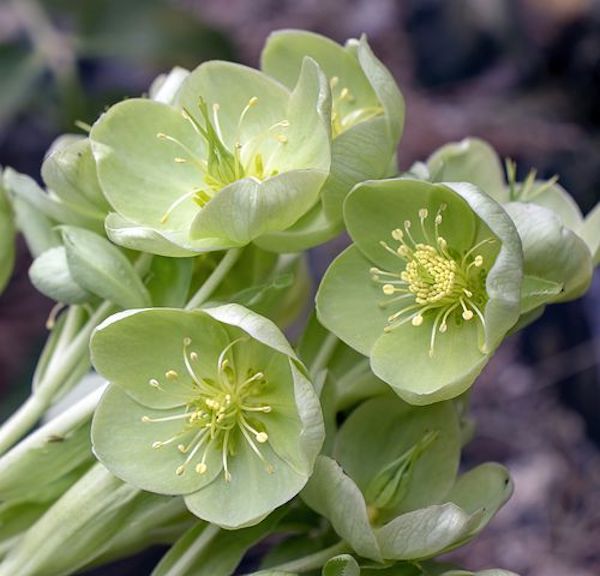
Green. Green flowers include: bells of ireland, zinnias, chrysanthemums, hellebores and hydrangeas. Those who prefer the color green in their gardens are likely practical and down-to-earth. They are often sought out for their advice. They enjoy nature and find balance in life important. Green lovers are also problem solvers and often think outside the box.
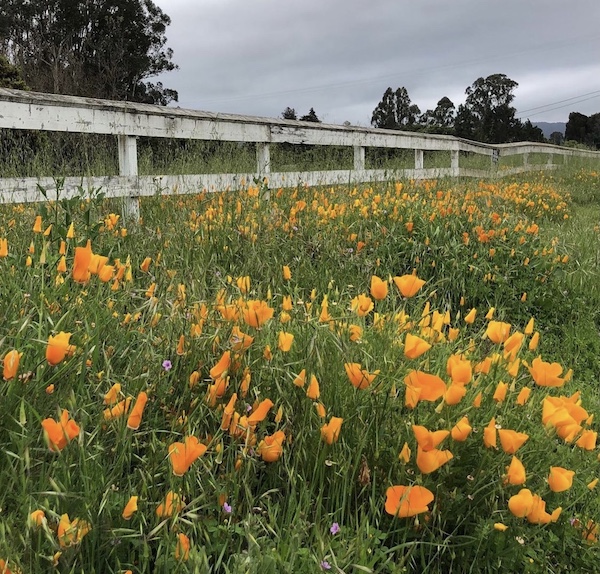
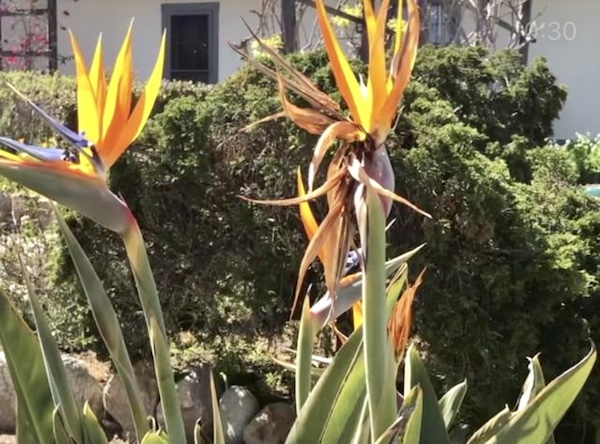
Orange. Orange lovers may like poppies, marigolds, bird of paradise, tiger lilies and dahlias. Gardeners who love orange tend to be fun and playful, nurturing, social butterflies, cheerful, and love to get things done in a timely fashion.
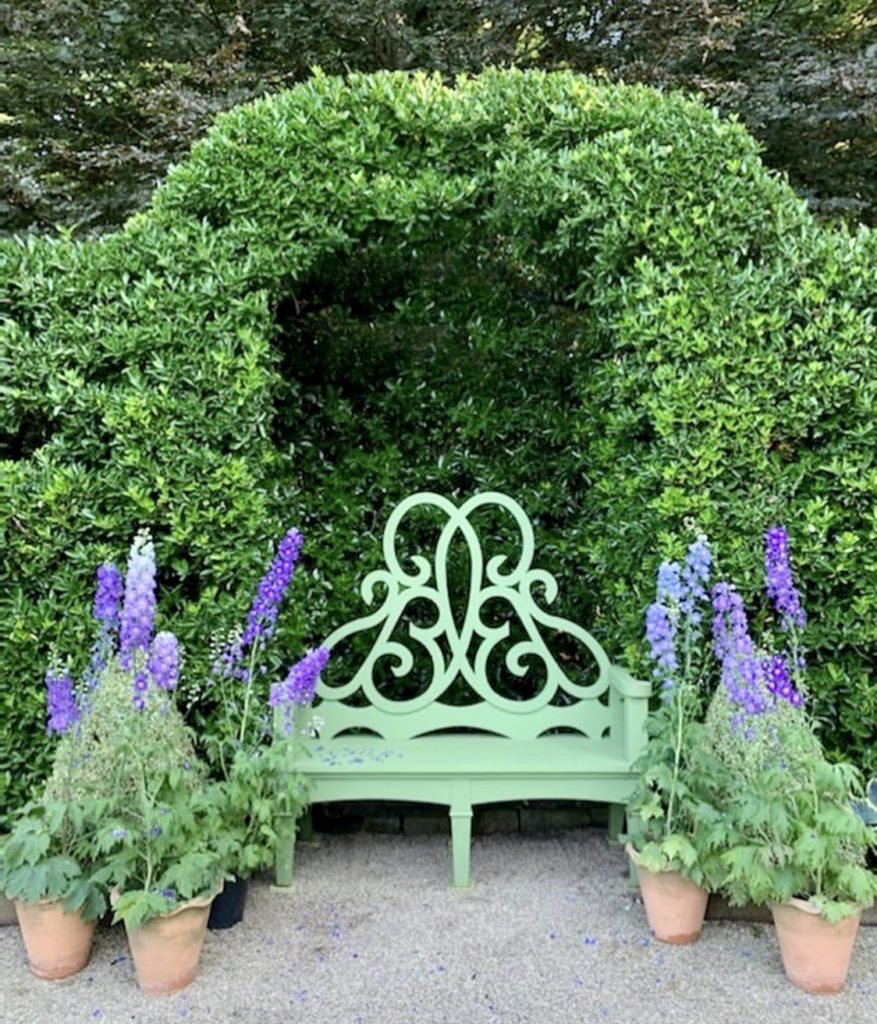
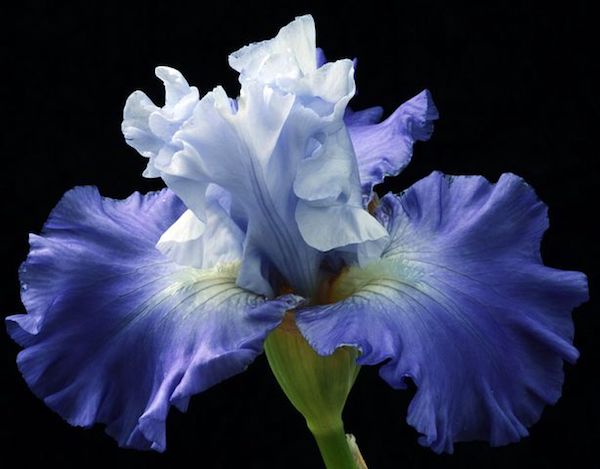
Purple. Verbena, lavender, clematis, bellflower, and iris are flowers purple lovers may choose. Purple loving gardeners are highly individualistic and quick-witted. They thrive on creativity, uniqueness, and random inspiration. They are not afraid to dance to the beat of their own drum.
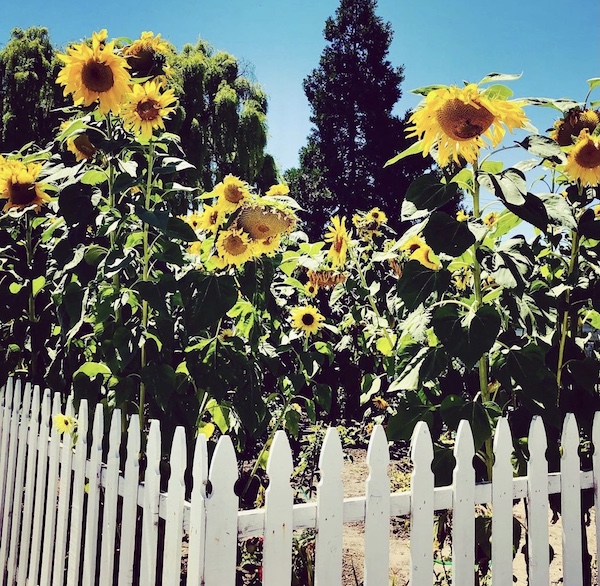

Yellow. Sunflowers, marigolds, yarrow, calendula and day lilies are favorites of yellow loving gardeners. Yellow is a color associated with optimism, cheerfulness, and imagination. You may tend to exert a calming influence on others. Those who love this color often have a positive spirit and are faithful friends.
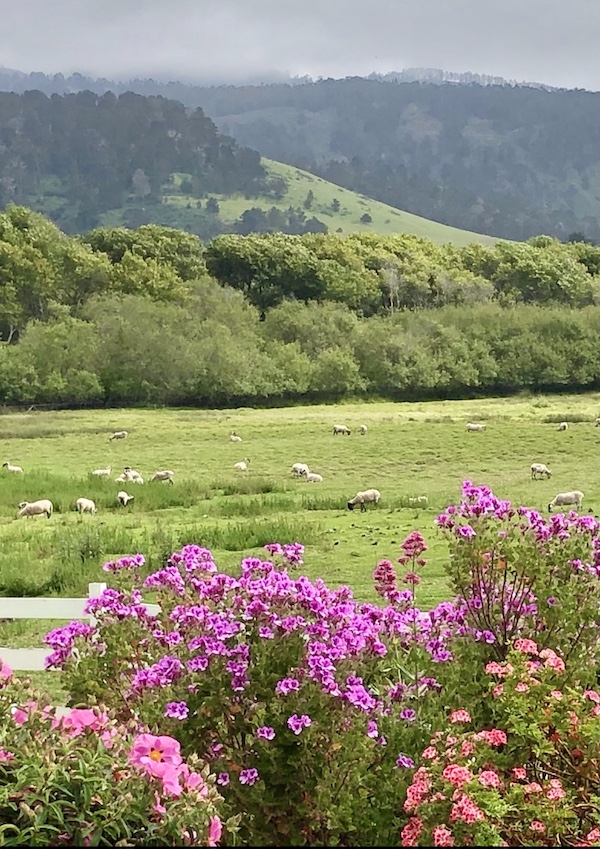

Pink. Pink roses, peonies, sweet peas, zinnias, stocks, and clematis are admired by pink loving gardeners. If you are drawn to pink, you tend to be warm, charming and embrace romance. Having fun and being playful are also qualities associated with pink lovers. Pink lovers are also tend be family oriented and feel comfortable showing their emotions. The expression “wearing your heart on your sleeve” may apply to you if you love pink.
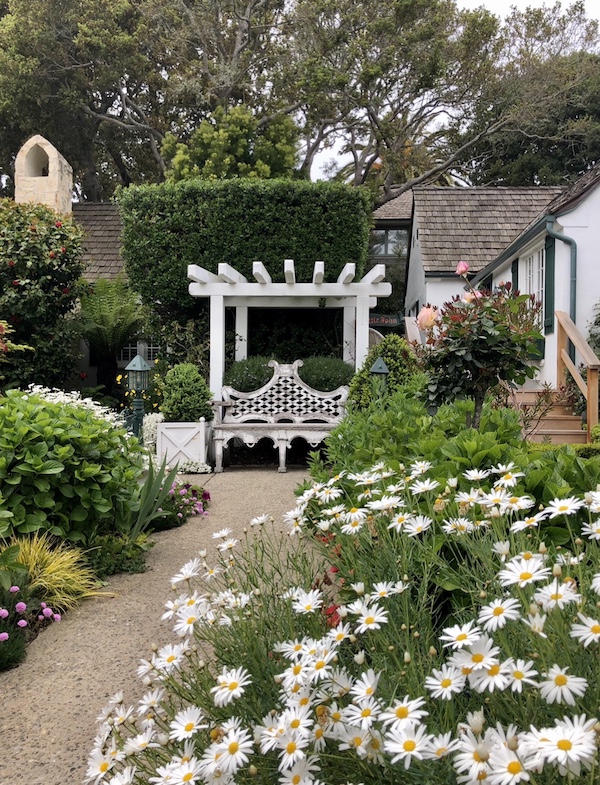
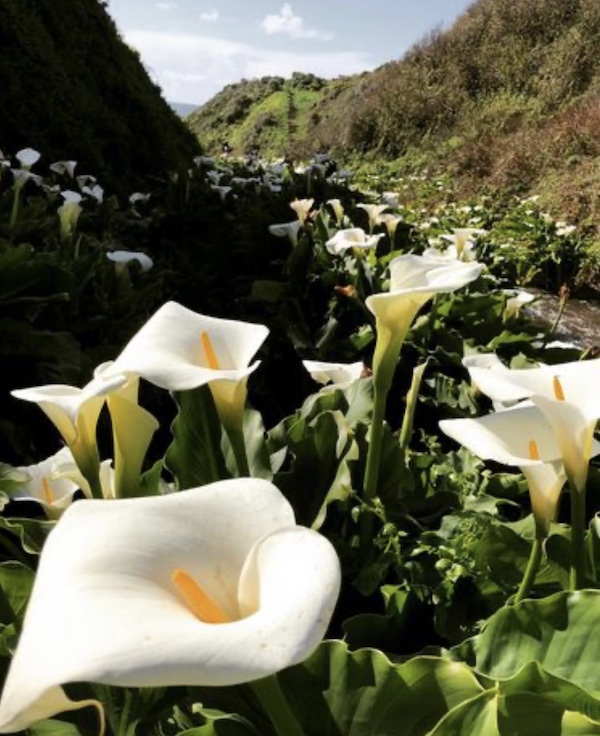
White. Baby’s breath, cleome, cosmos, jasmine, daisies and calla lilies are flowers white loving gardeners may be drawn to. If you love white flowers, you tend to be a calm and peaceful person, searching for the perfect zen in your garden. You like things clean, simple, and orderly. White is also associated with innocence and naivety.

What color flowers do you like? It is interesting to learn about how color and personality are linked! You may want to explore this topic further by reading Garden Flower Folklore, by Laura C. Martin. You may also enjoy Prettiest Wildflowers in Monterey County, From A-Z and The Secret Gardens of Historic Monterey. Thank you for visiting my blog! Wishing you peace, joy, happiness, and beautiful vistas!
-
Prettiest Wildflowers in Monterey County, From A-Z
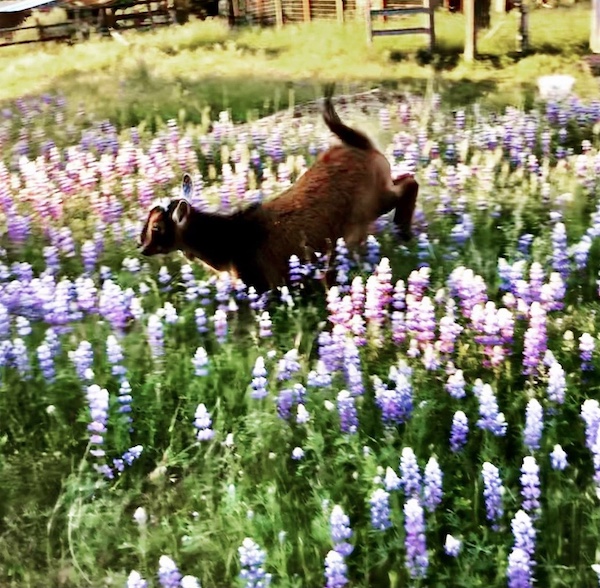
In the spring, life begins anew here in Monterey County. It is definitely my favorite time of year, because everything is lush and green, baby animals, birds, and butterflies begin to appear, and of course, my beloved wildflowers begin to bloom. I first became interested in wildflowers because I found so many on my farm as well as when I was hiking locally. Here is a list of what I think are the prettiest wildflowers in my neck of the woods, from A-Z.

A is for Amaryllis belladonna, also known as Naked Ladies. These bright pink lilies don’t appear until the leaves disappear, hence the name. It’s always magical when they begin blooming! I took this photo a few years ago at my farm. I now have many more because I keep dividing them!
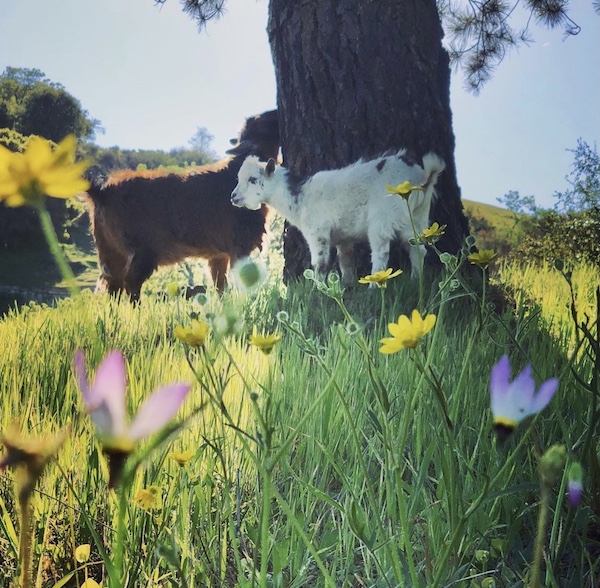
B is for Buttercup. The California Buttercups arrive soon after the Shooting Stars appear here on the farm.
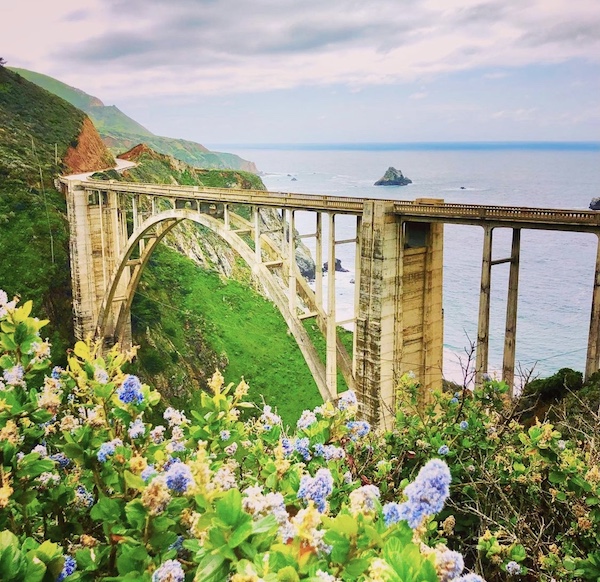
C is for Ceanothus, or California Lilac. Here you see them growing near Bixby Bridge, in Big Sur. I also have them at the farm and the bees just love them!
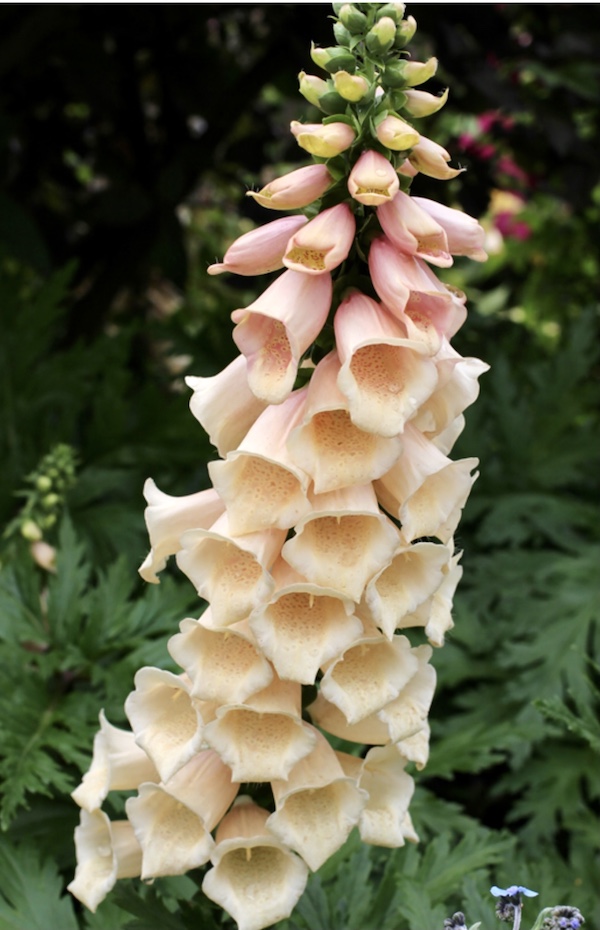
D is for Digitalis, also known as Foxglove. One thing I love about these is that gophers leave them alone! They are prettiest when grown in groups.

E is for Elegant Canyon Clarkia. Just too gorgeous for words.
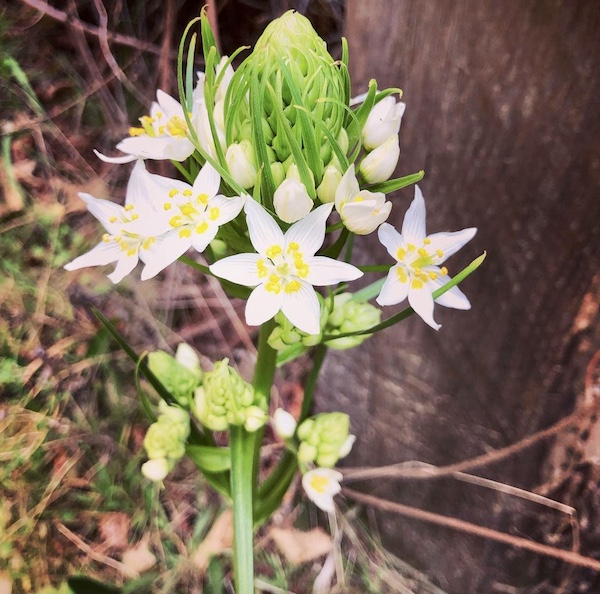
F is for Fremont’s Star Lily. I took this photo at Partington’s Cove in Big Sur.

G is for Golden Star, all known as Pretty Face. These also grow wild along my road.
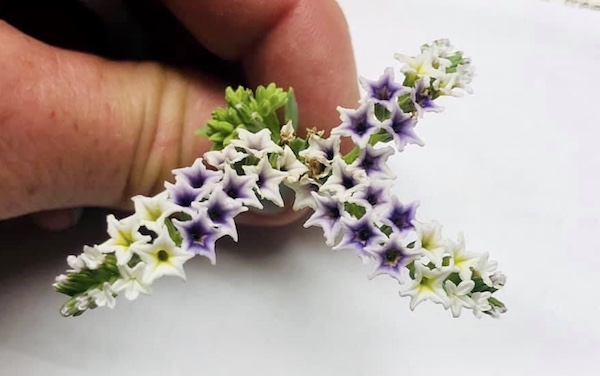
H is for Heliotrope, also know as “Seaside” Heliotrope, although this was way out here in the pastures of heaven! I just think they are so cool, how about you?

I is for Iris. Their vibrant shade is just gorgeous. You see these often down in Big Sur.

J is for Johnny Jump Ups, also known as California Golden Violets. They appear on my farm every year.

K is for Kniphofia, also known as Red-hot Poker Plant. These tall orange spikes look like candles and are quite stunning in large groups. This photo was taken near Delmonte Beach in Monterey.

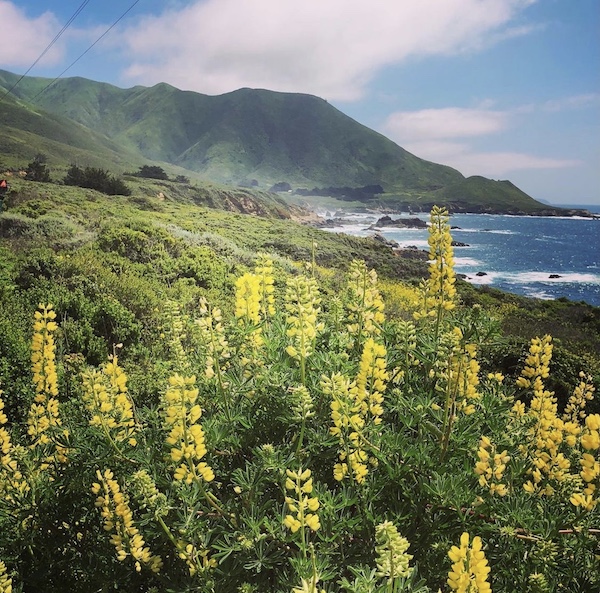
L is for Lupines. Whether purple or yellow, they are so, so pretty. They change my farm into a magical fairy tale every spring, as long as we have enough rain! Sasha enjoys posing amongst the lupines in the countryside near our farm. The second photo is of yellow lupines in Big Sur. Note that it is not the more invasive French Broom, the leaves are a giveaway.

M is for Morning Glories. I love these pink and white ones I found growing along the trail above Garrapata State Beach in Big Sur.
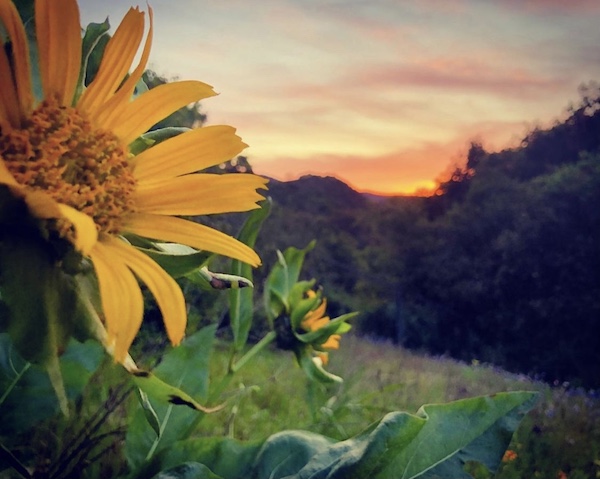
M is also for Mule Ears. They look like sunflowers. This photo was taken at my farm.
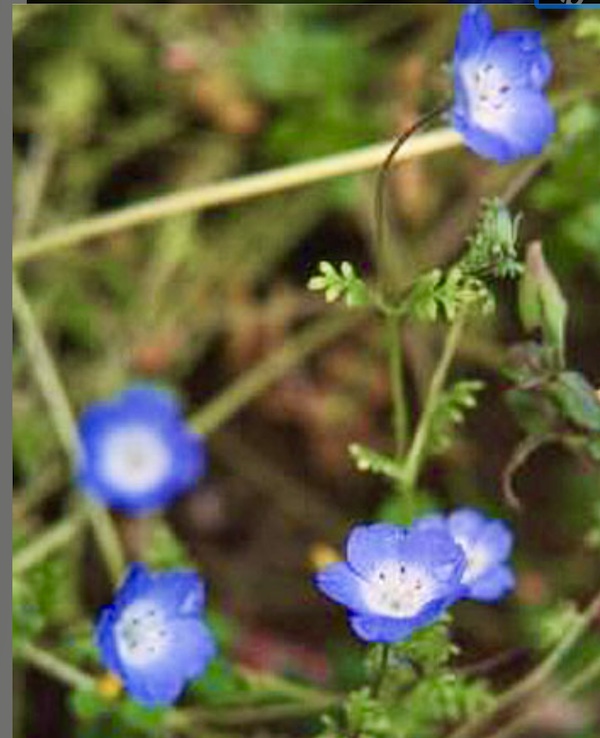
N is for Nemophila, commonly called Baby Blue-eyes. These are my favorite spring wildflowers because I just love the color!
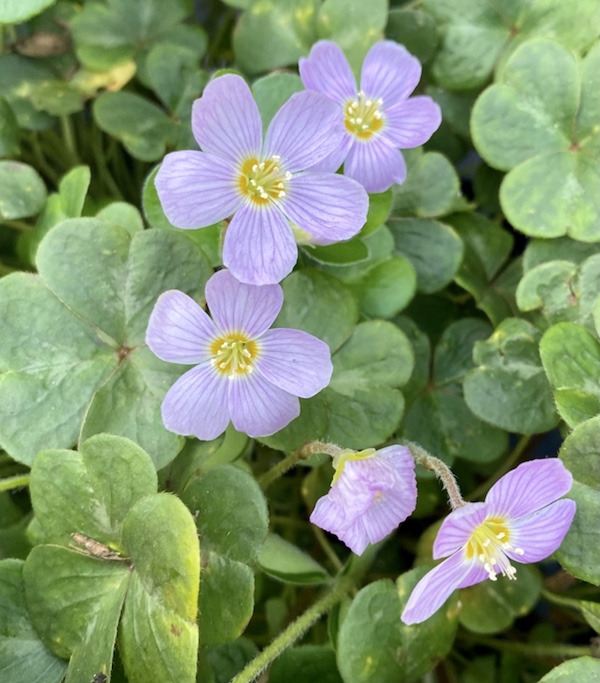
O is for oxalis, also known as Redwood Sorrel. An interesting fact about Redwood Sorrel is that when the leaves are in direct sunlight, they will start to shrivel and fold down. This is because too much sun can harm the shade loving plant.
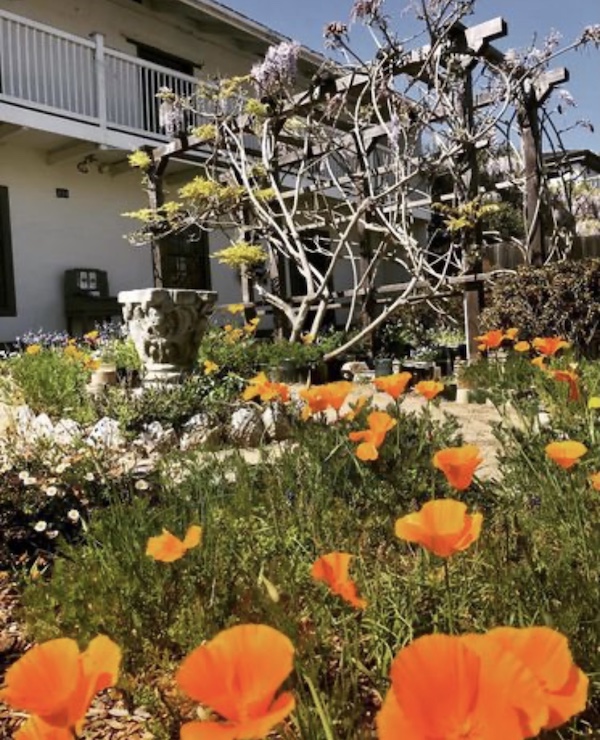
P is for Poppies. California poppies proliferate at Casa Soberanes in Monterey.

P is also for Padre’s Shooting Star, the first flowers to bloom at my farm in the spring! I adore them!
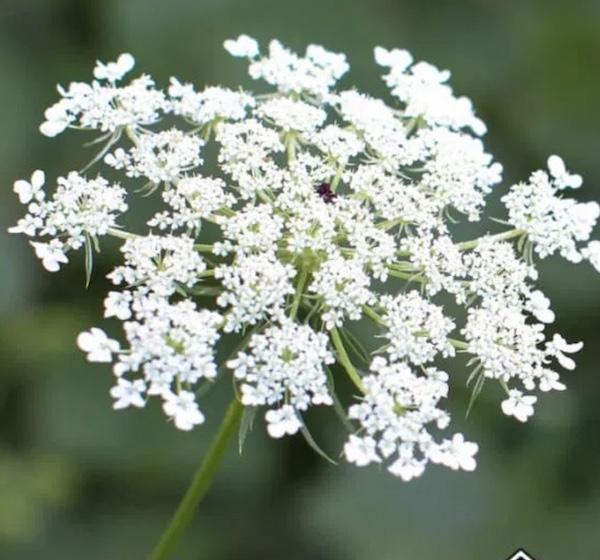
Q is for Queen Anne’s Lace. Named after the ornate lace once worn by the queen of England, this wildflower is beautiful but also quite invasive.

R is for Wild Radish. Also known as Sea Radish, White Charlock and Jointed Charlock, this is in the family Brasicaceae. This photo was taken at Lovers Point in Pacific Grove.
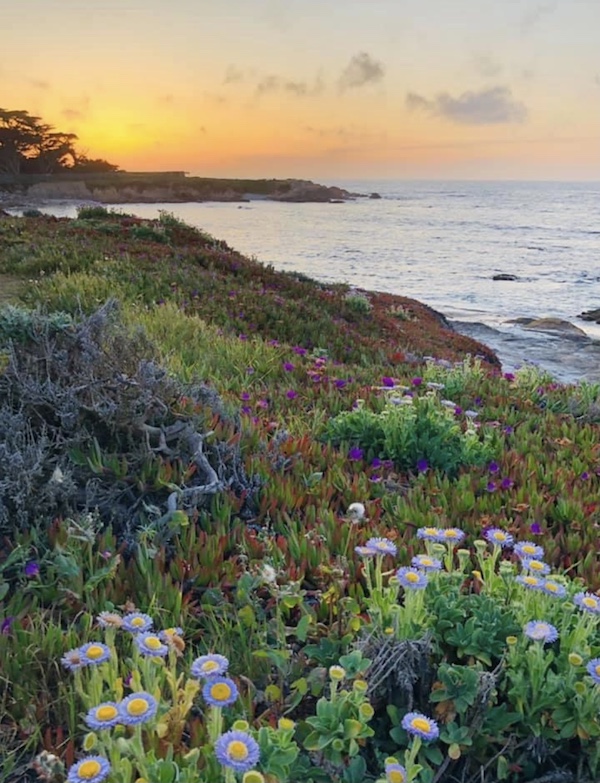
S is for Seaside Daisies. Pebble Beach is the prettiest at sunset, especially when there are wildflowers.

S is also for Sea Statice. Love the crisp color of these blooms with the ocean as a backdrop. This is near Delmonte Beach in Monterey.

T is for Thistle. This photo was taken just north of Rocky Point in Big Sur.
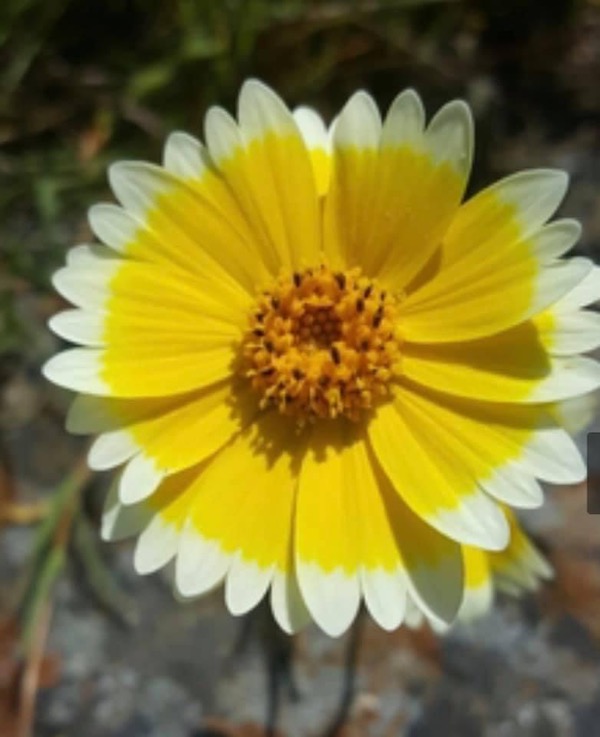
T is also for Tidy Tips. These grow in the pasture near my neighbor’s home. I think these are just the prettiest tiny flowers!

U is for Uropappus, also known as Lindley’s Silverpuffs. They kind of look like dangerous dandelions. Regular dandelions turn from butter yellow to fuzzy white balls that you can make a wish on. These flowers turn into seed needles, and would be considered highly ineffective for wish making. They are, nonetheless, very pretty, (in a scary way).
.

V is for Vinca. This photo was taken at Ragged Point in Big Sur. The monarch butterflies were loving it!
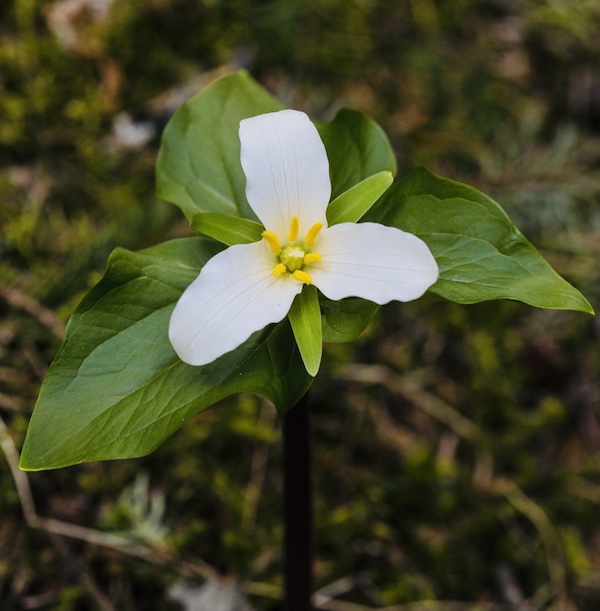
W is for Wakerobin, also known as Western Trillium. It loves moist, shady, wooded areas.
X….so I will admit, I had a heck of a time trying to think of a local wildflower beginning with the letter x. I did some research, and success! Apparently Xerophyllum tenax, also known as Bear Grass and Indian basket grass, grows here in Monterey County! I don’t have any photos, but for more information, see Xerophyllum tenax. I learned that this plant is important for fire ecology. Apparently, is has rhizomes that survive during fires and it thrives with periodic burns. Who knew??
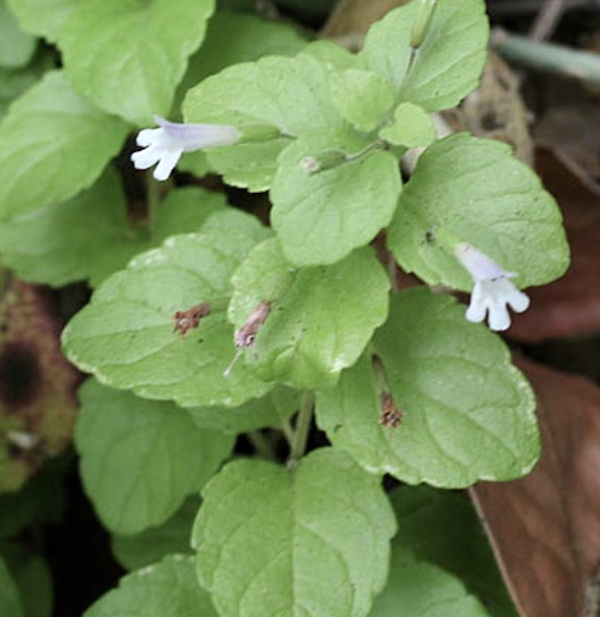
Y is for Yerba Buena. It may not be the prettiest, but it made my list because it’s still important. My friend Brian always points this out to me while hiking. For those of you who love to drink it in tea, here is what it looks like in nature!

Z is for Zantedeschia aethiopica, also known as Calla Lily. My favorite place to see them in the spring is Calla Lily Valley in Big Sur. This is one of the prettiest places to visit in Monterey County!
There are so many wildflowers out there I have yet to find. I love them not only for their beauty, but also for their enchanting names. Who wouldn’t love flowers called “Witches’ Teeth”, “Yawning Penstemon” and “Snouted Monkeyflower”?
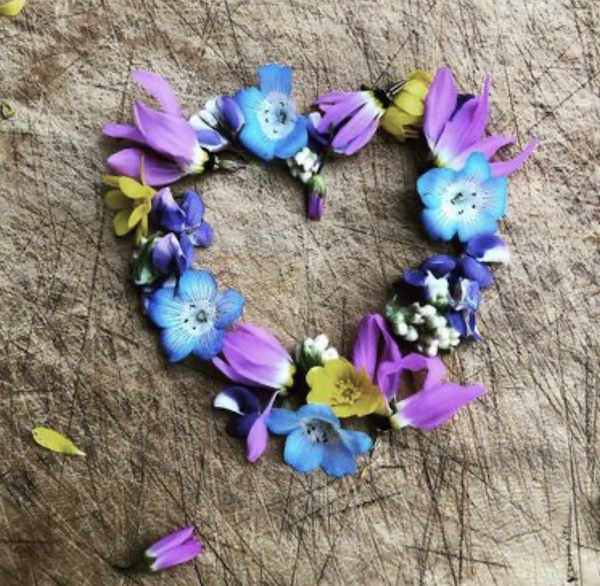
Thank you for visiting my blog! I hope you enjoyed viewing the prettiest wildflowers in Monterey County. I would love to hear which are your favorites! You may enjoy learning more about our wildflowers by reading Monterey County Wildflowers, A Field Guide, by Rod M. Yeager, MD and Michael Mitchell. You may also enjoy Seven Best Places for Wildflowers in Monterey County! Wishing you peace, joy, happiness, and beautiful vistas!
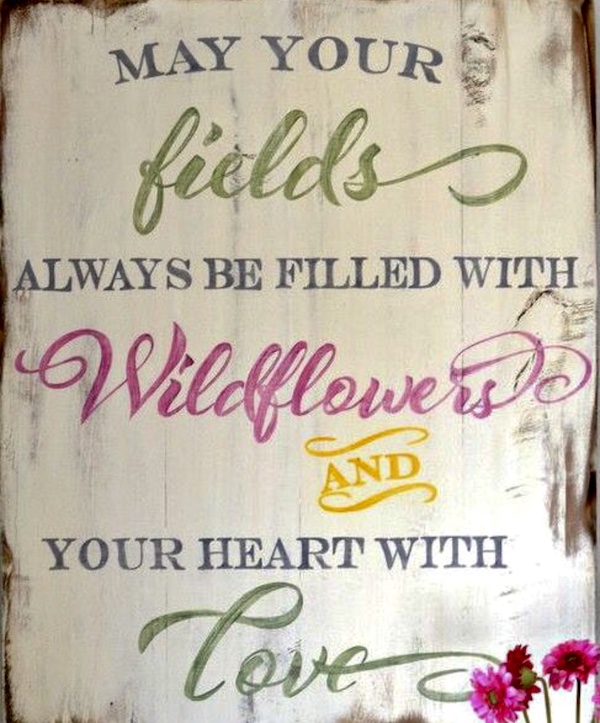
Source: pinterest.com
